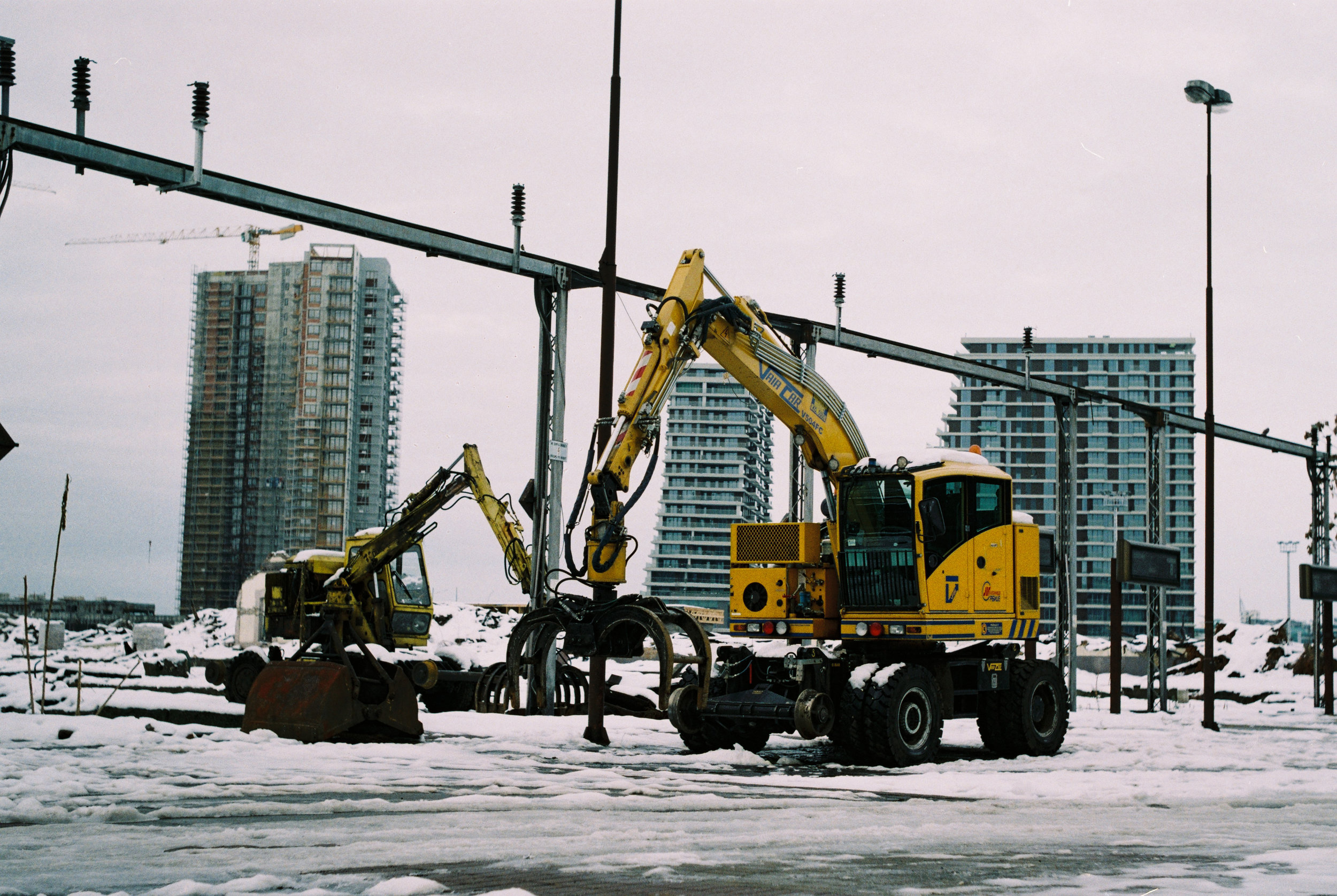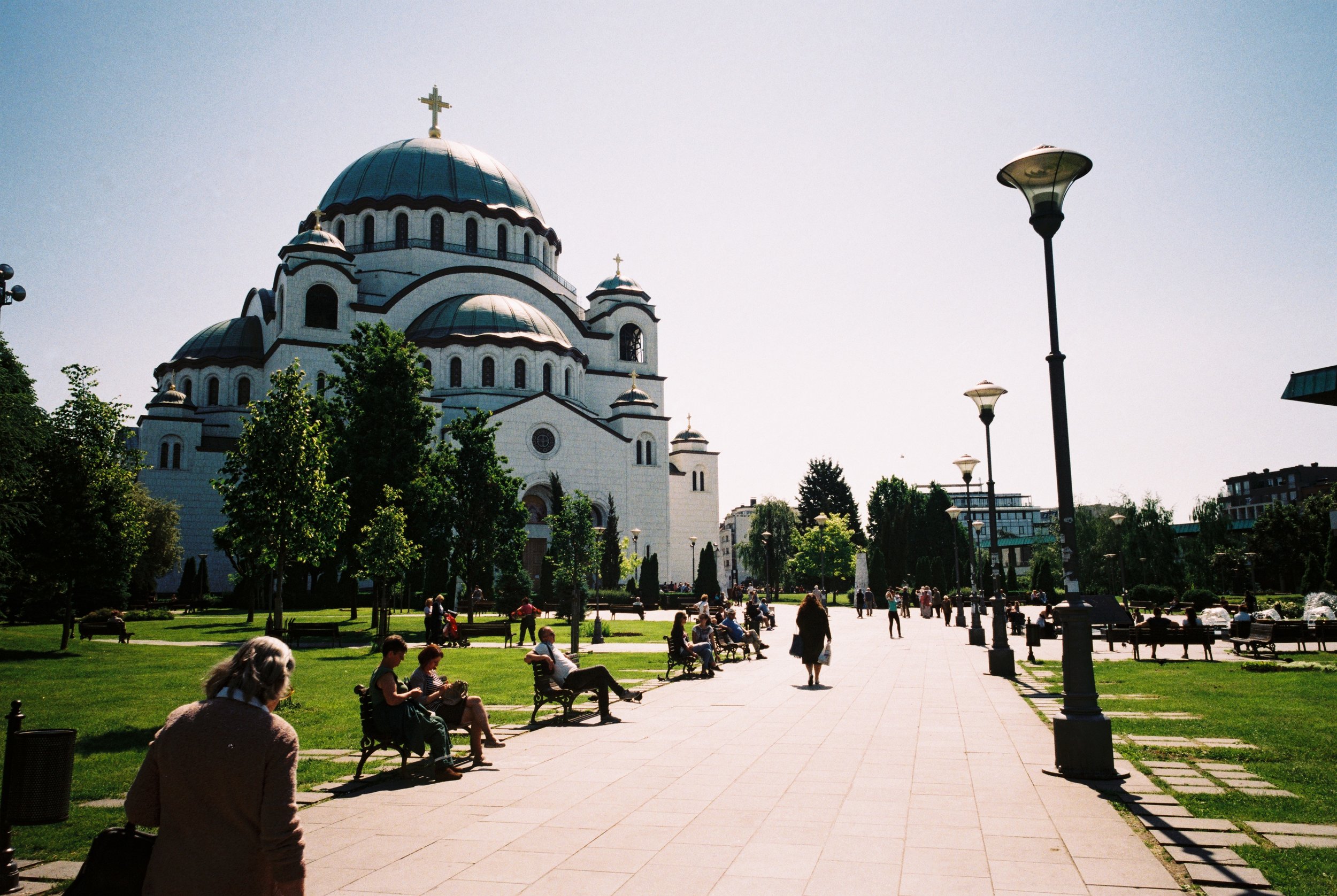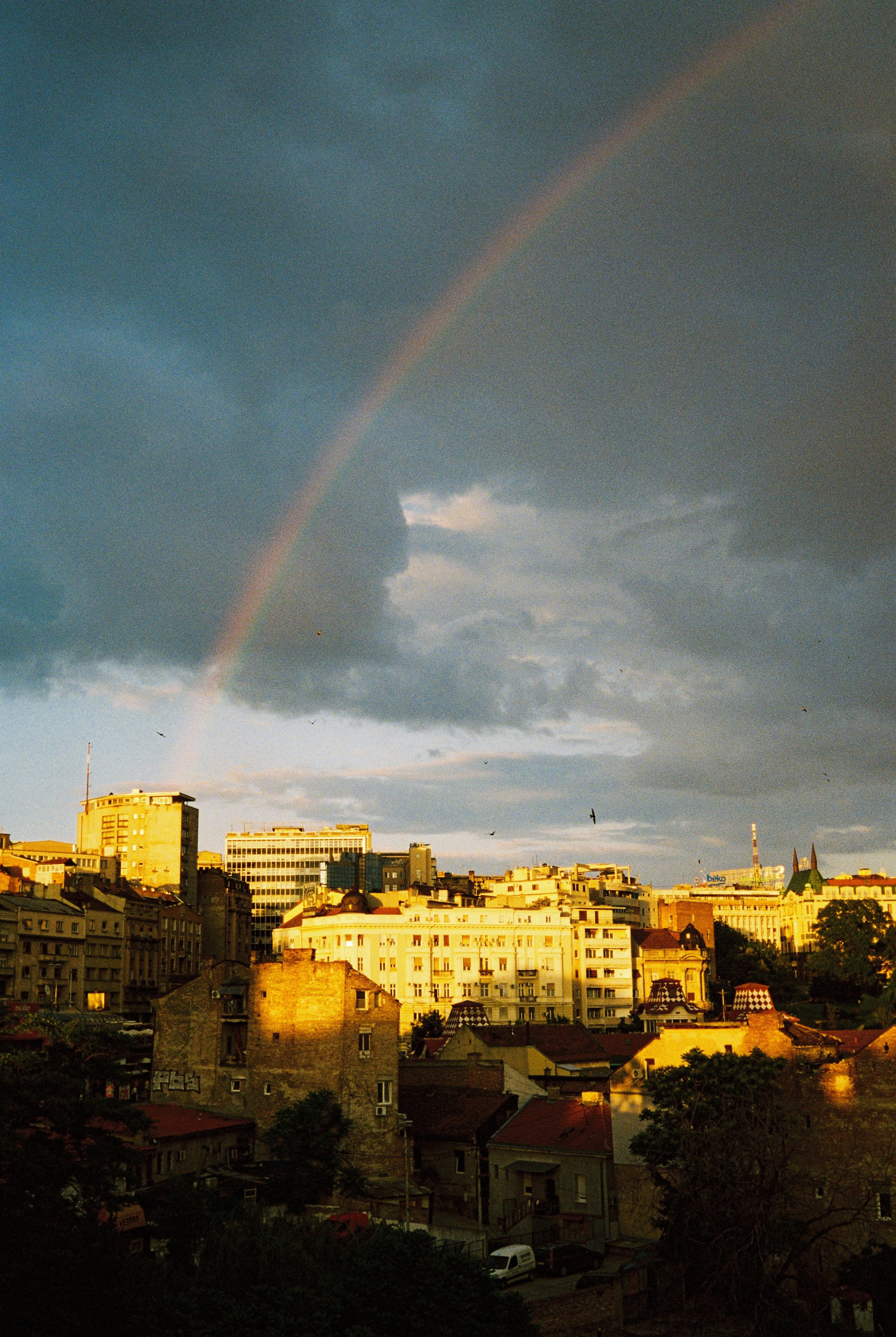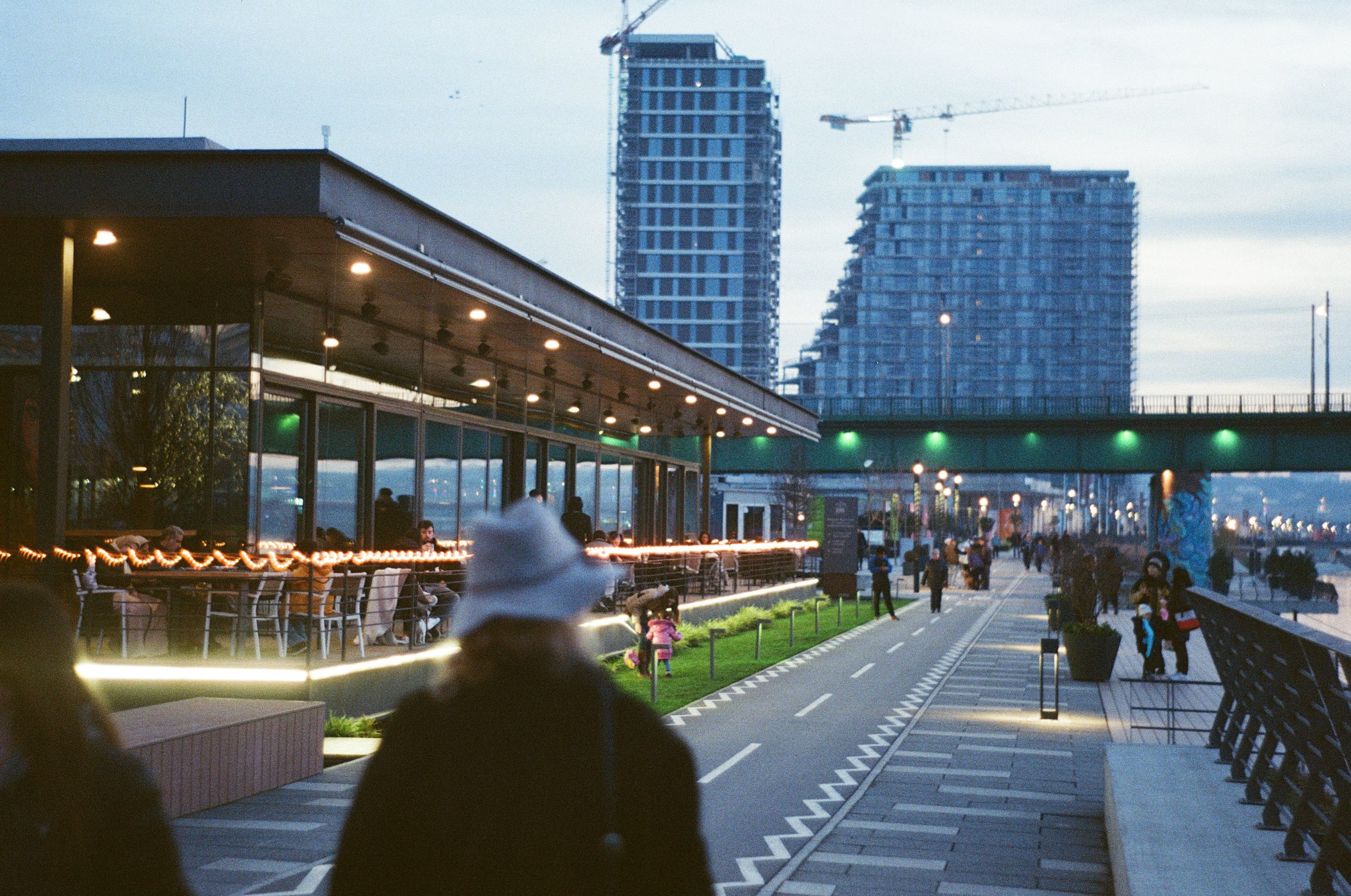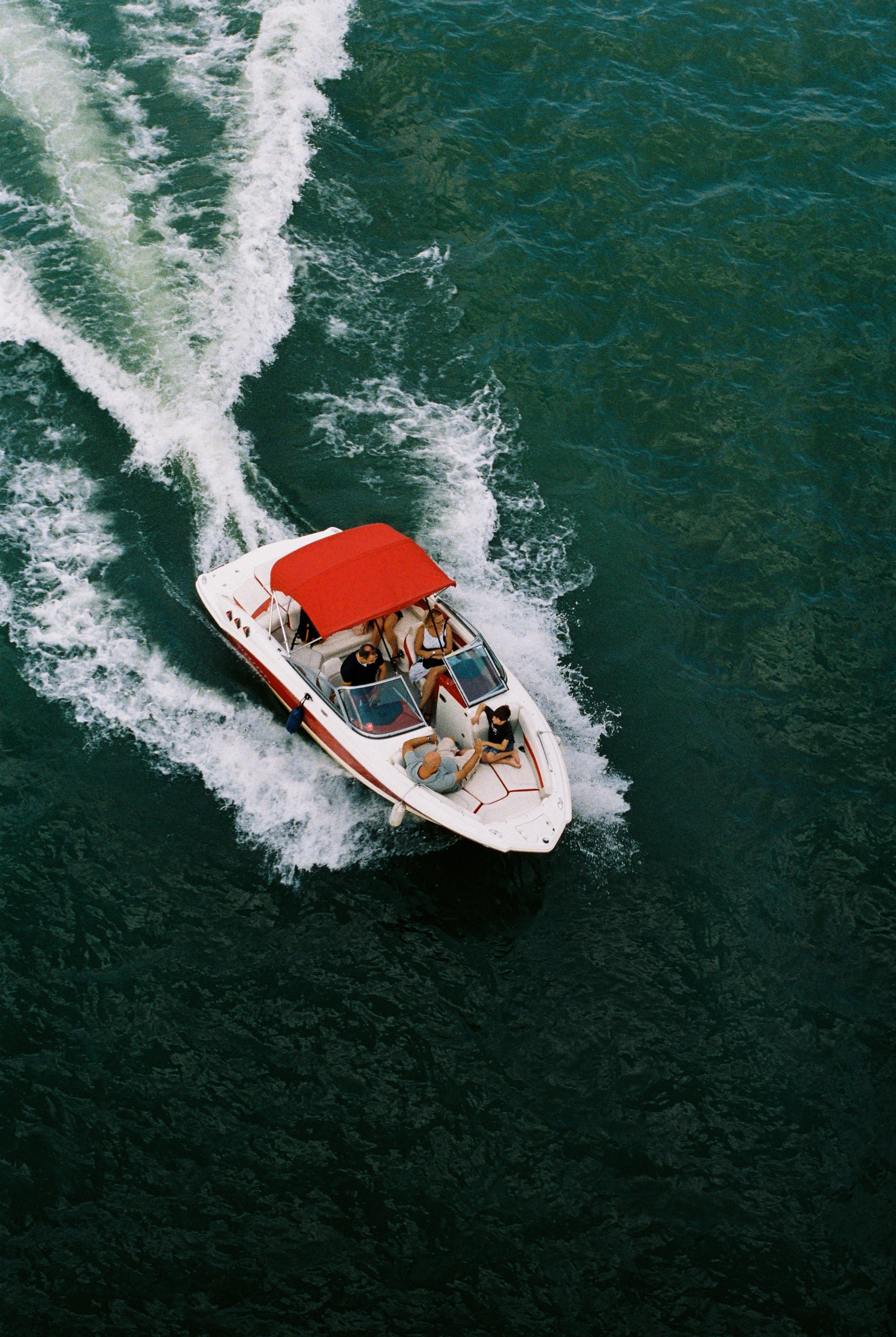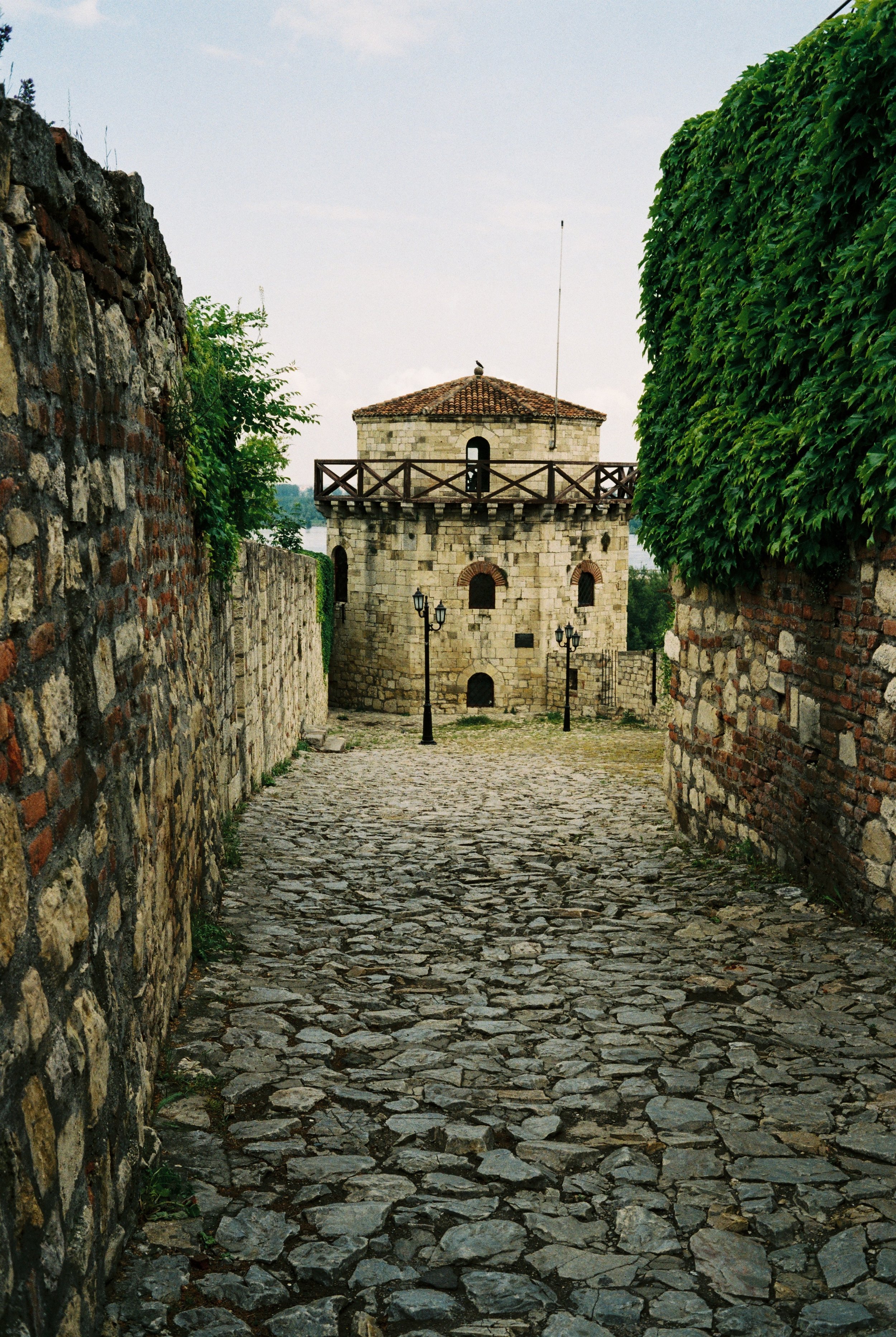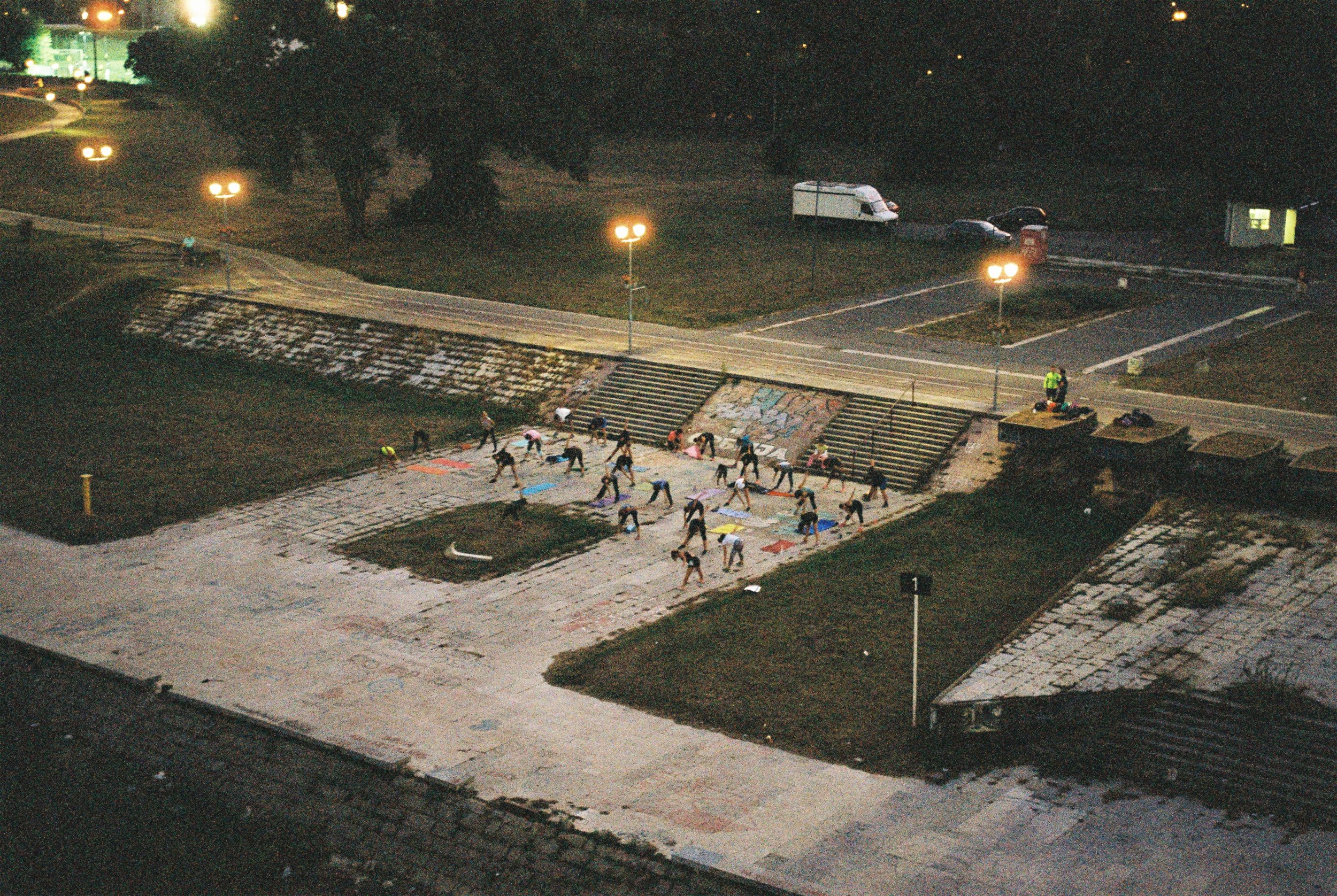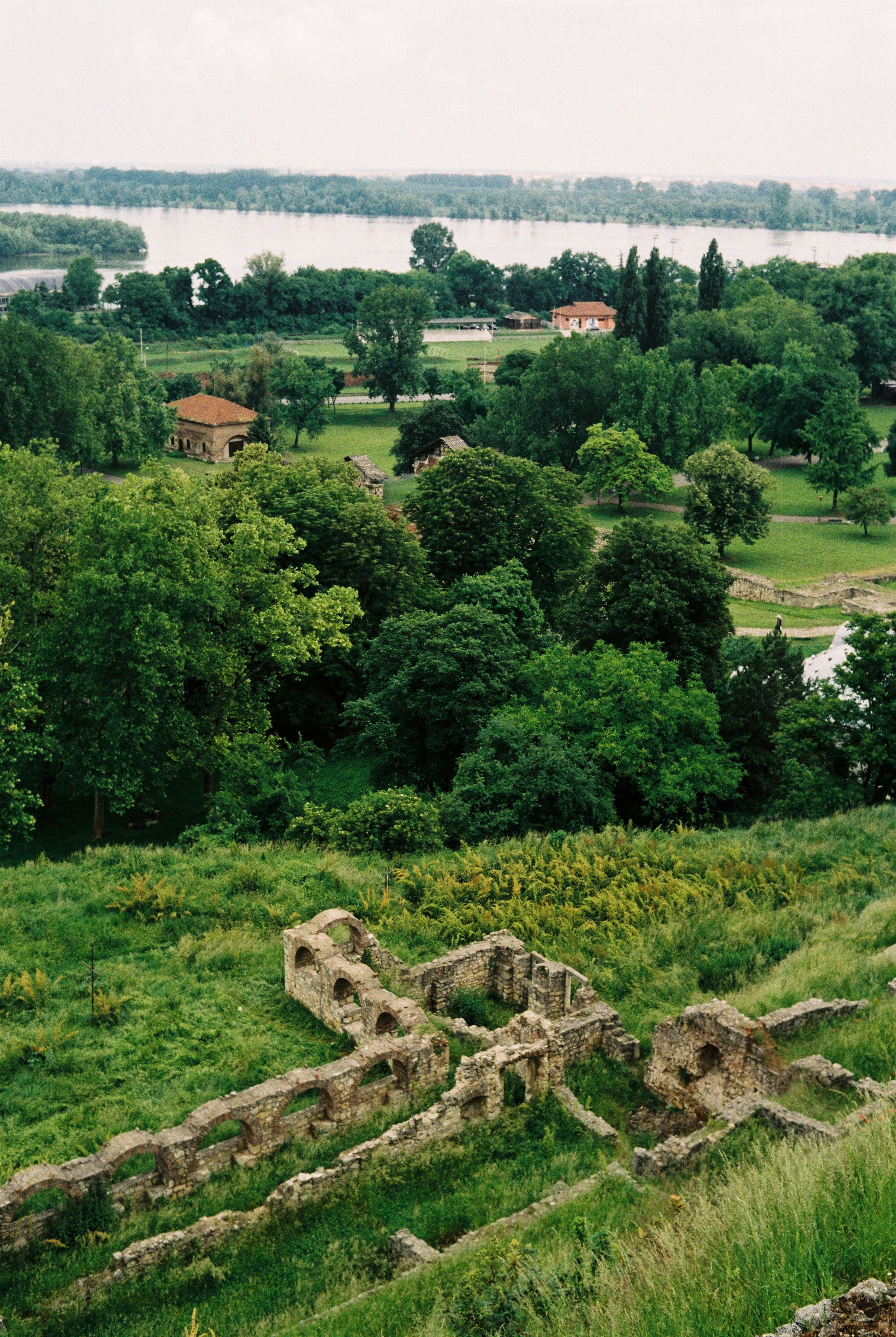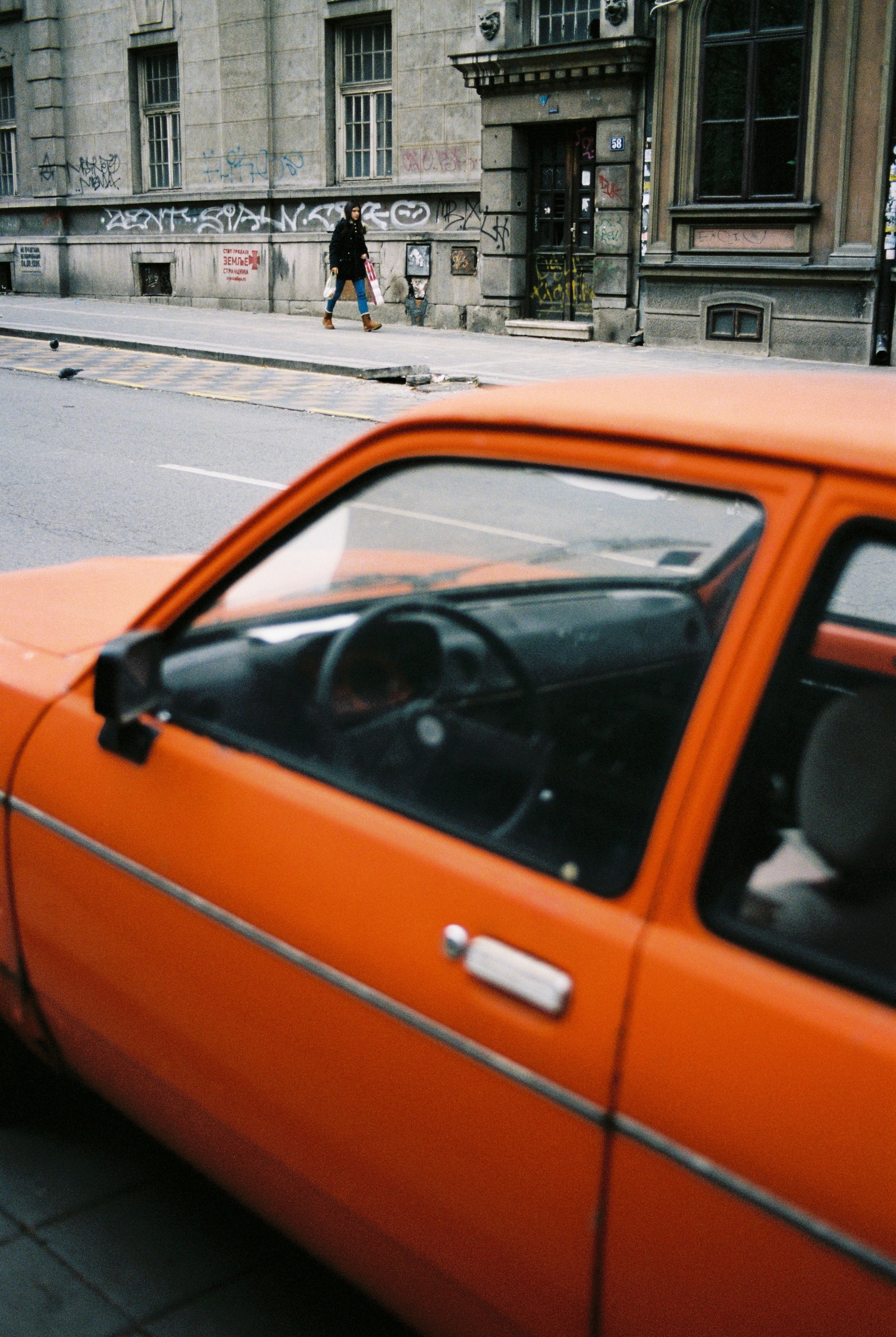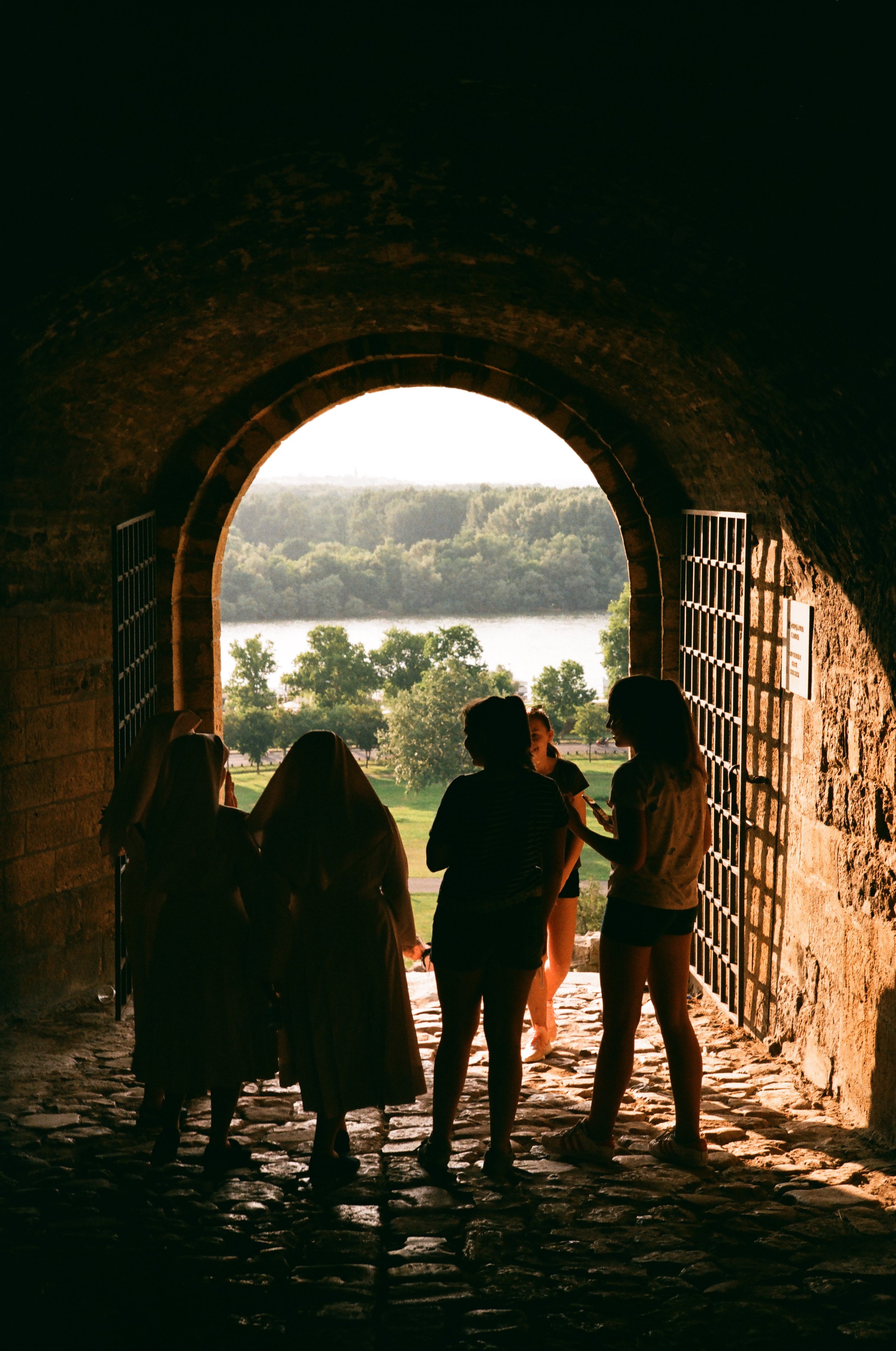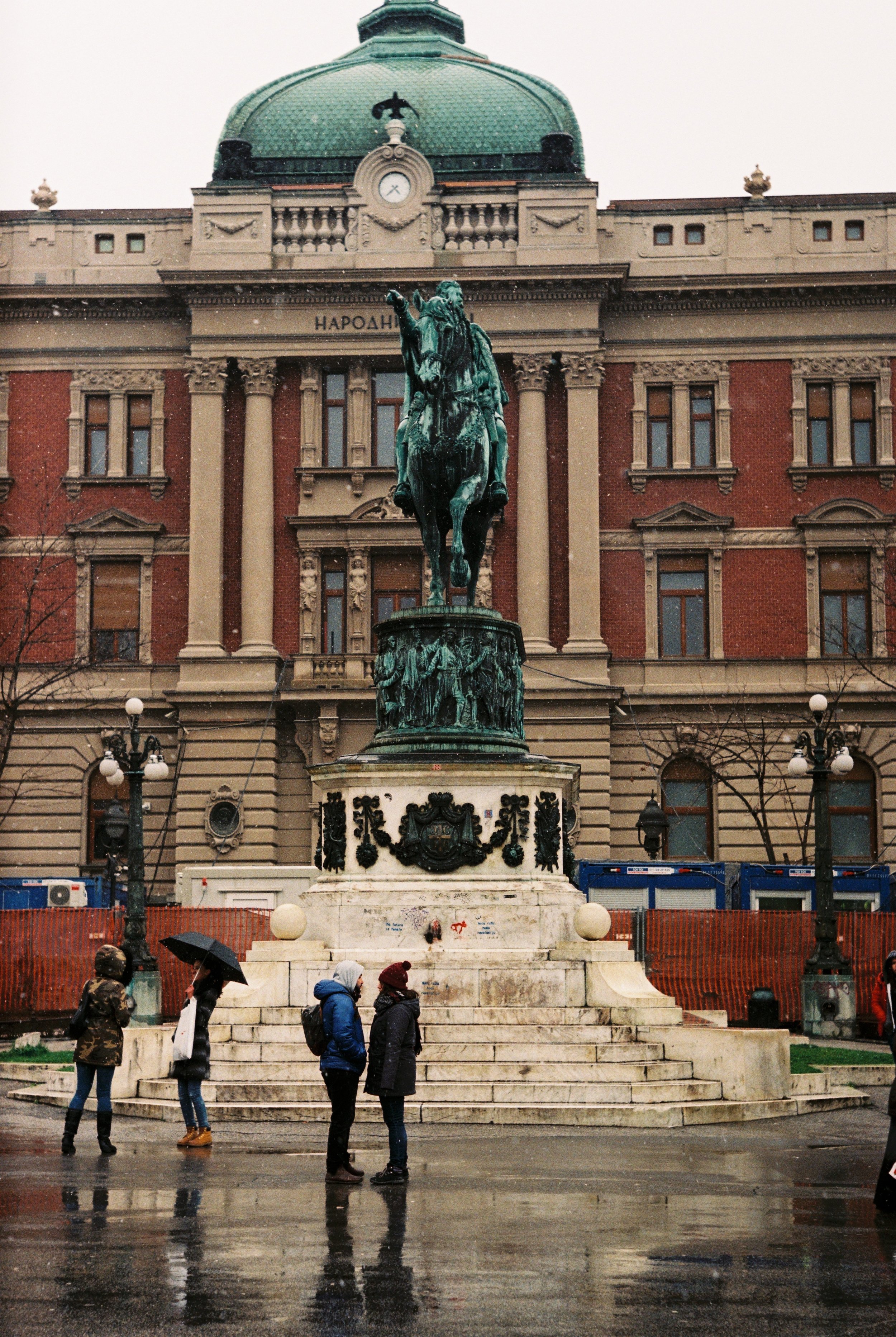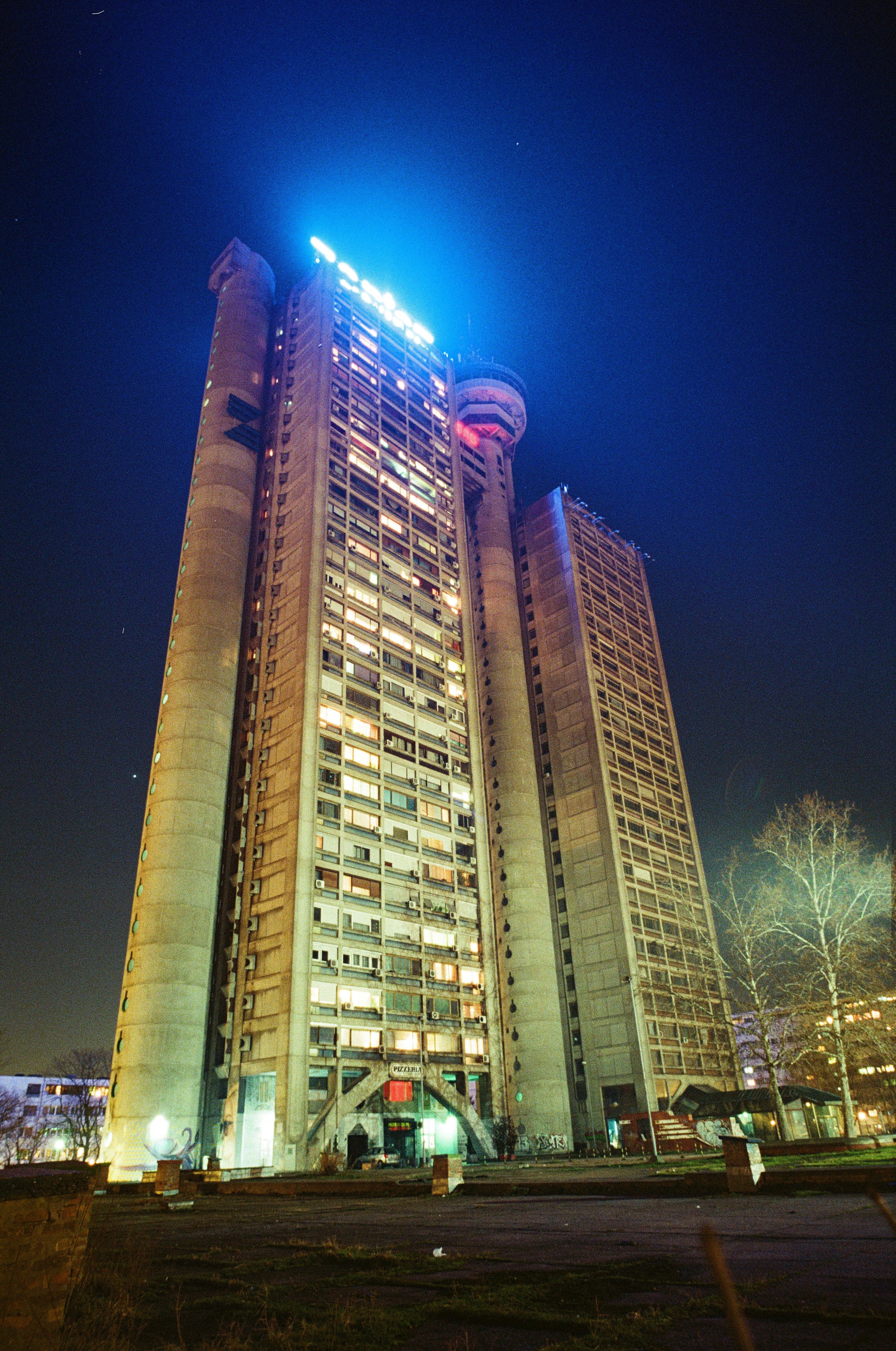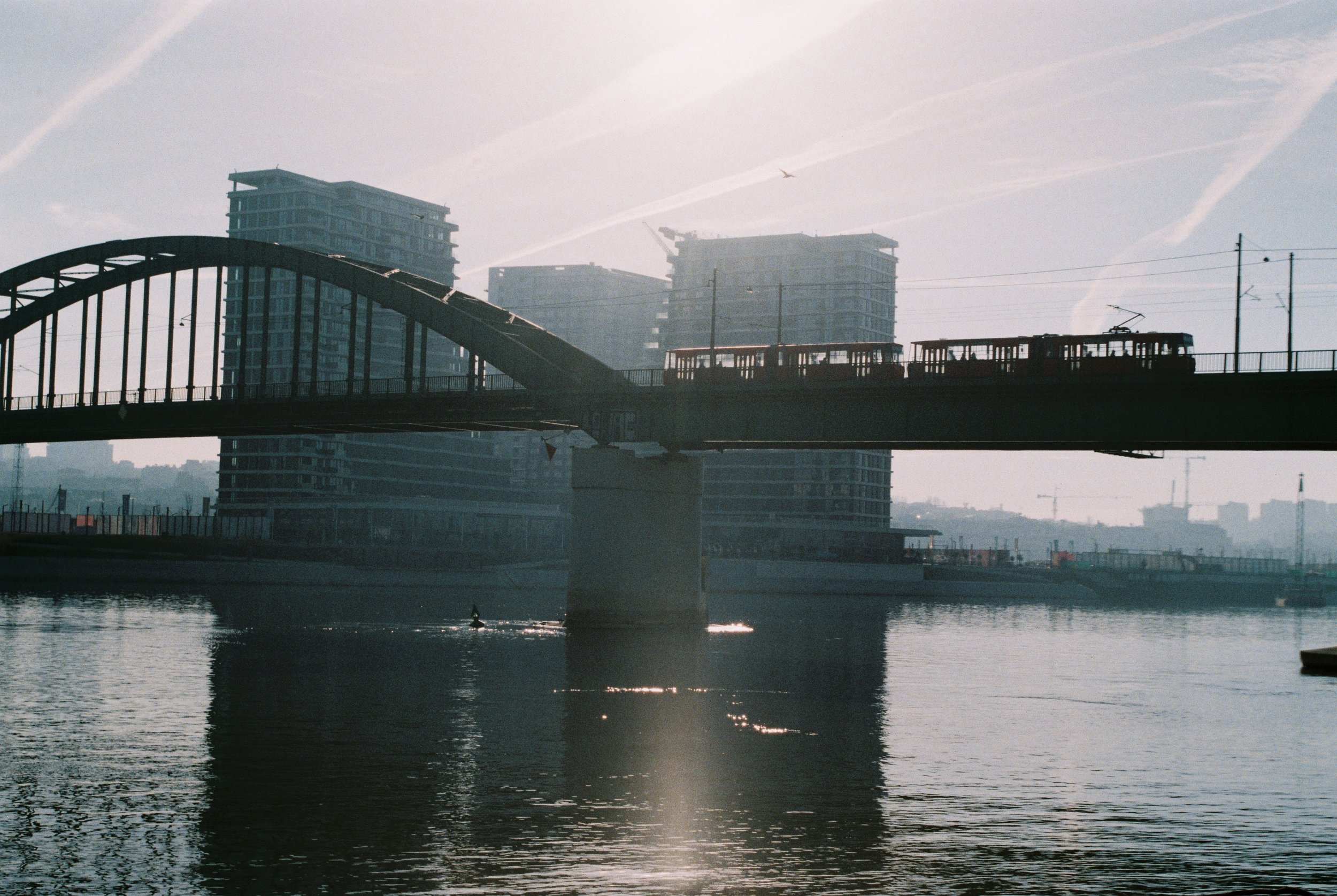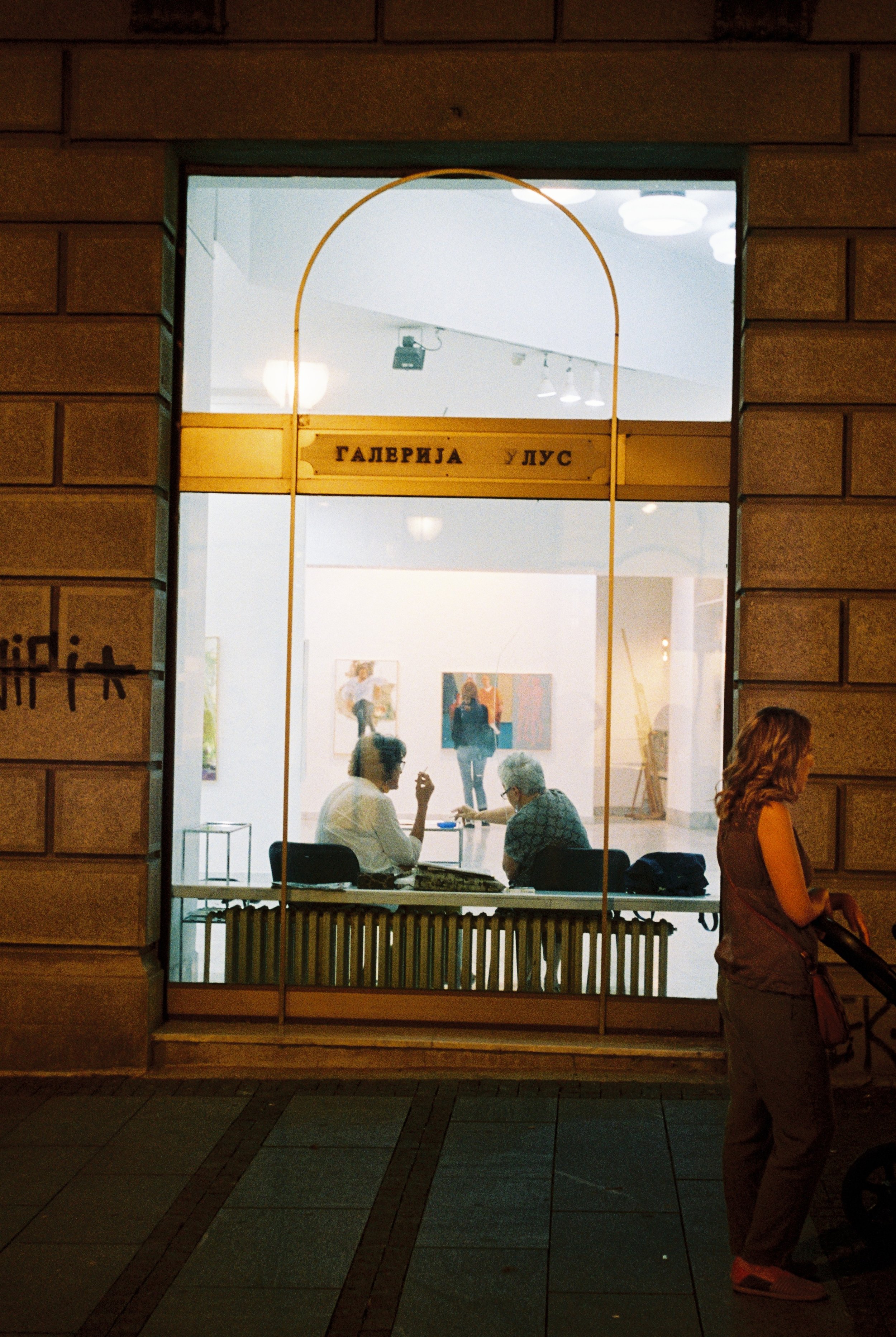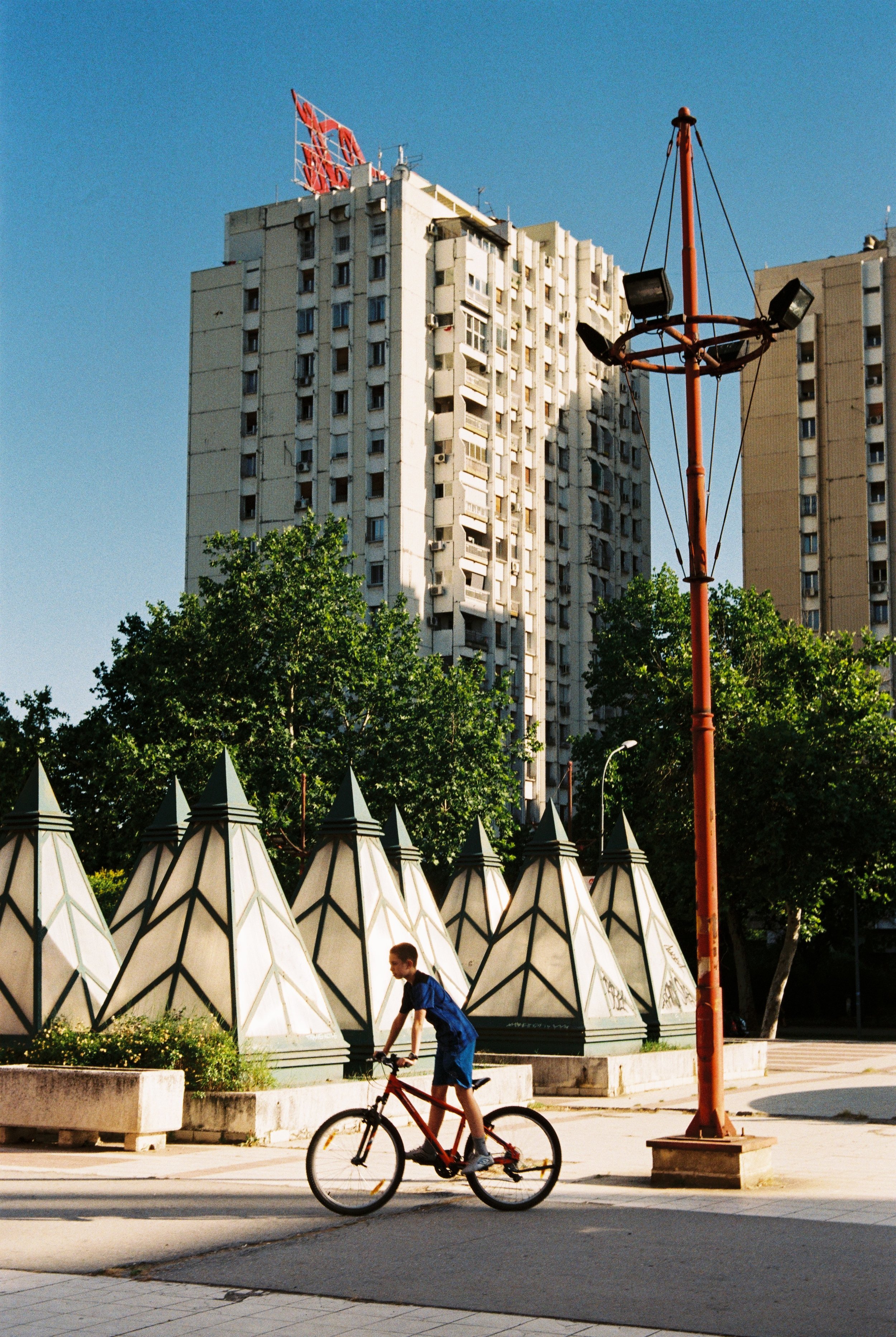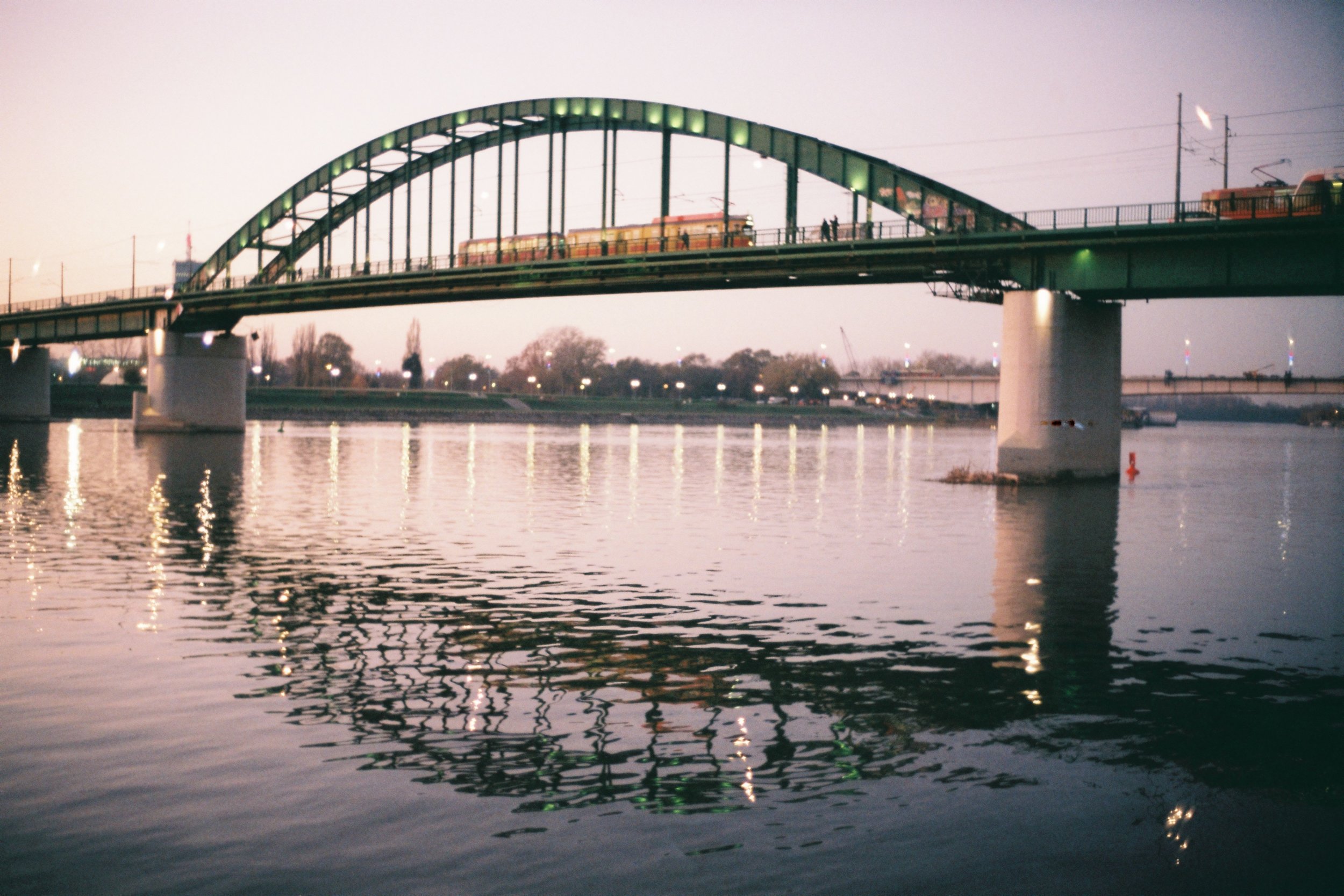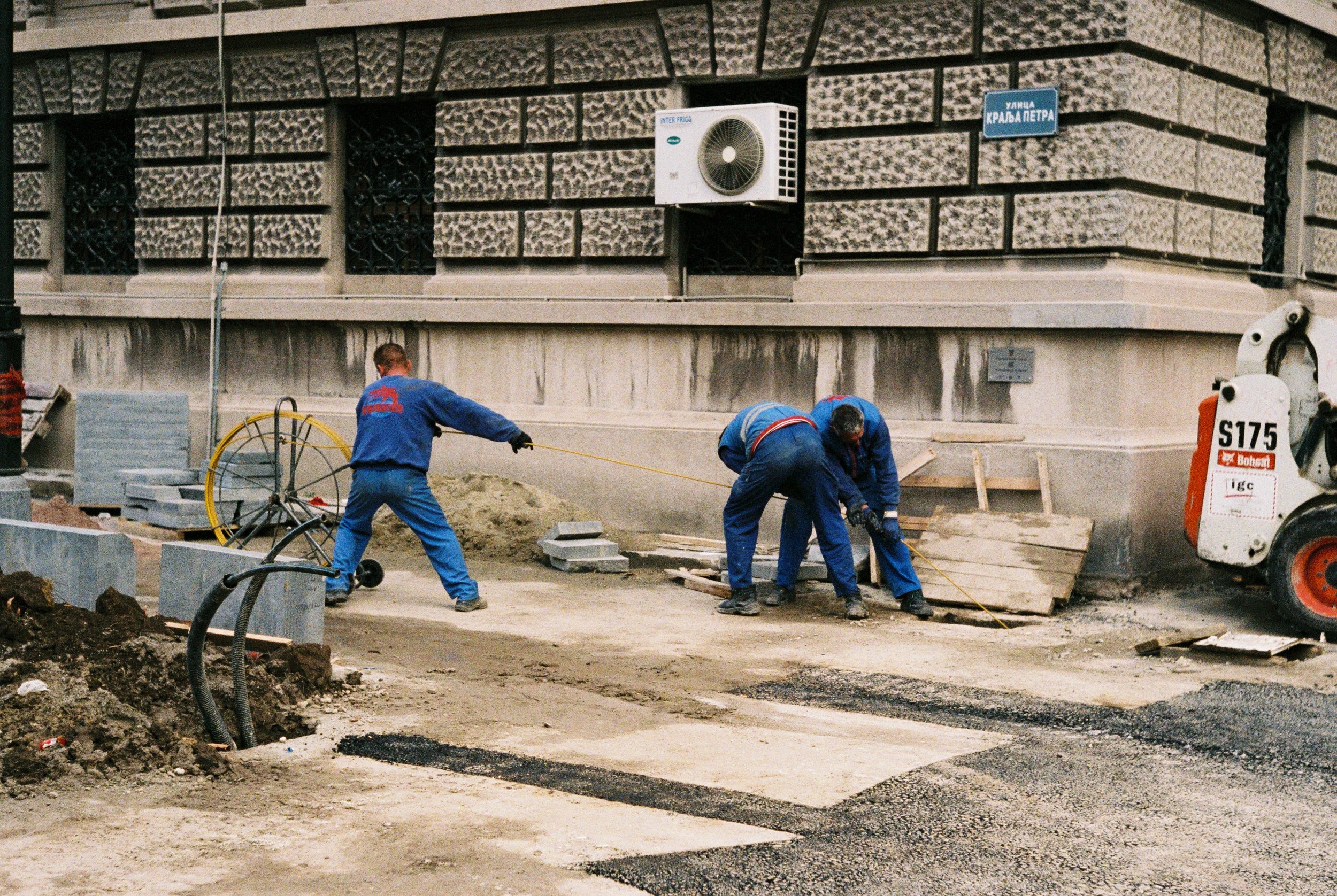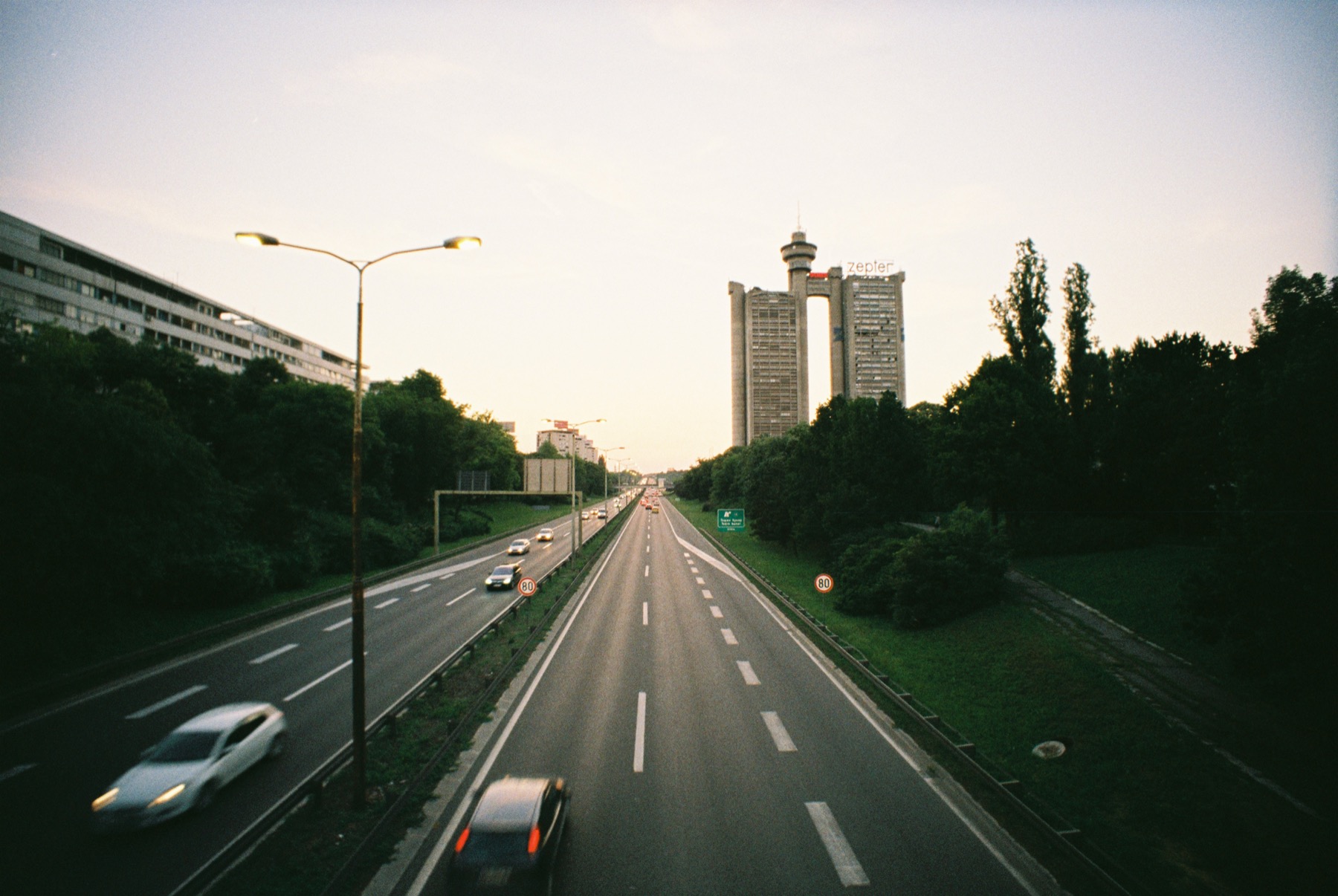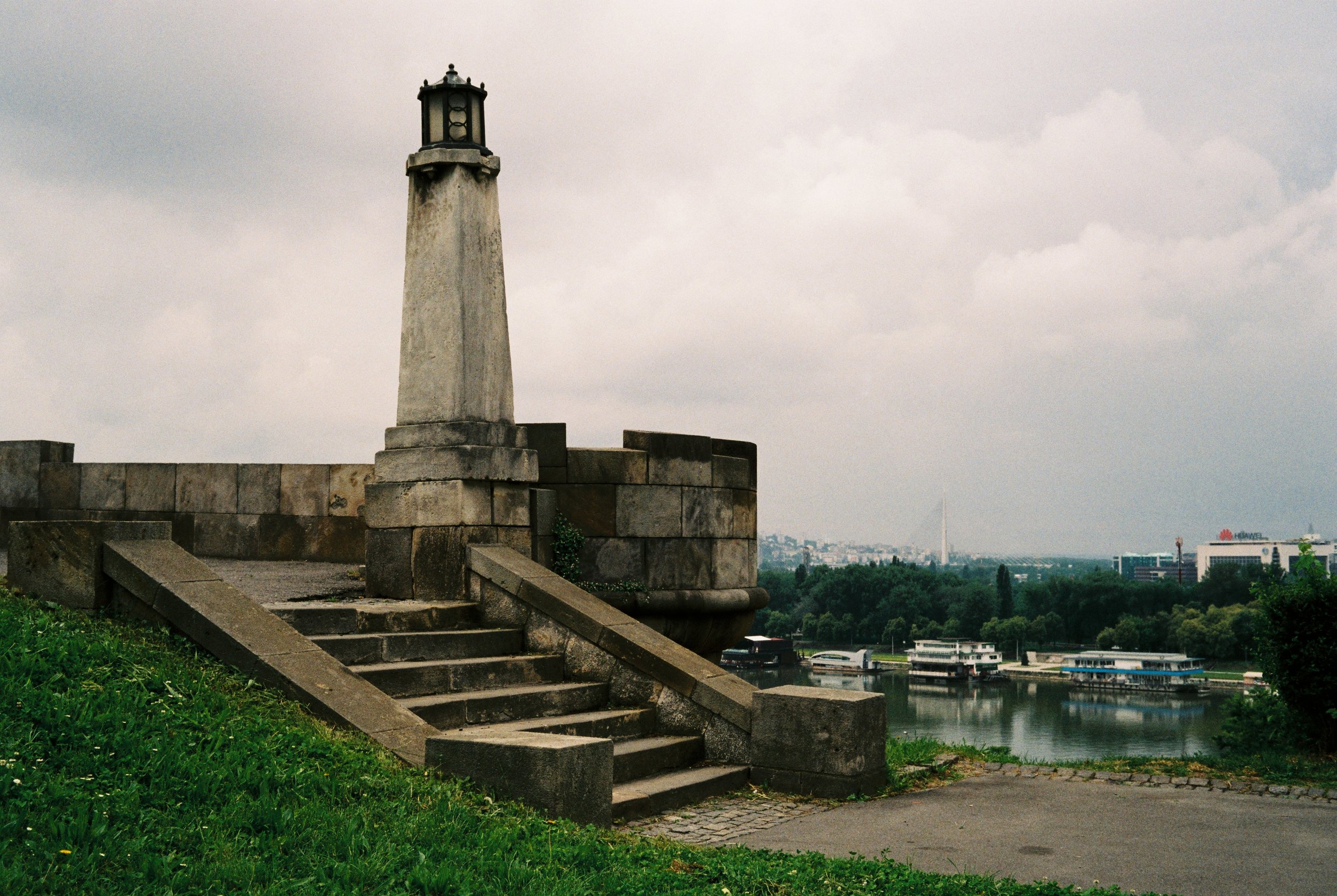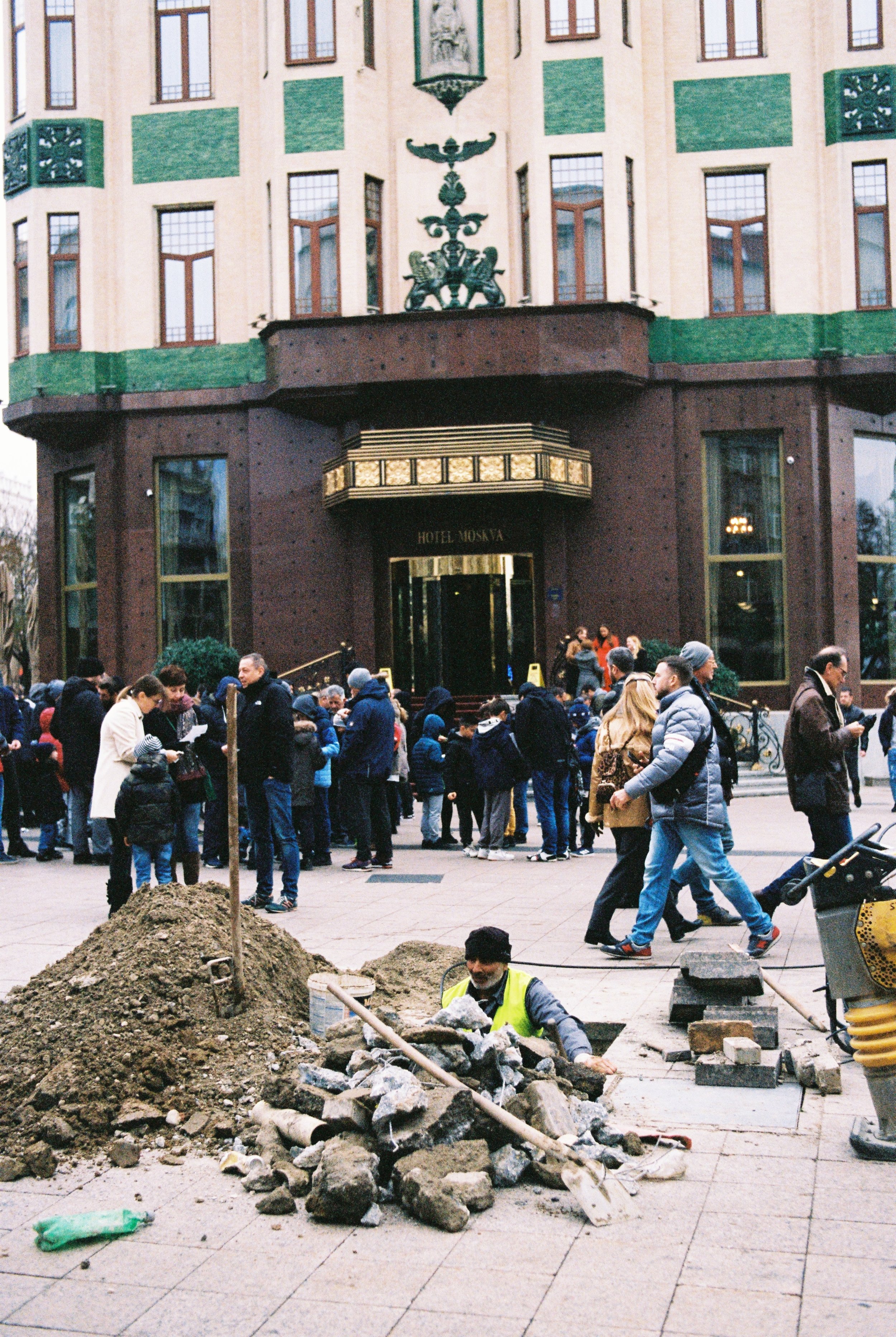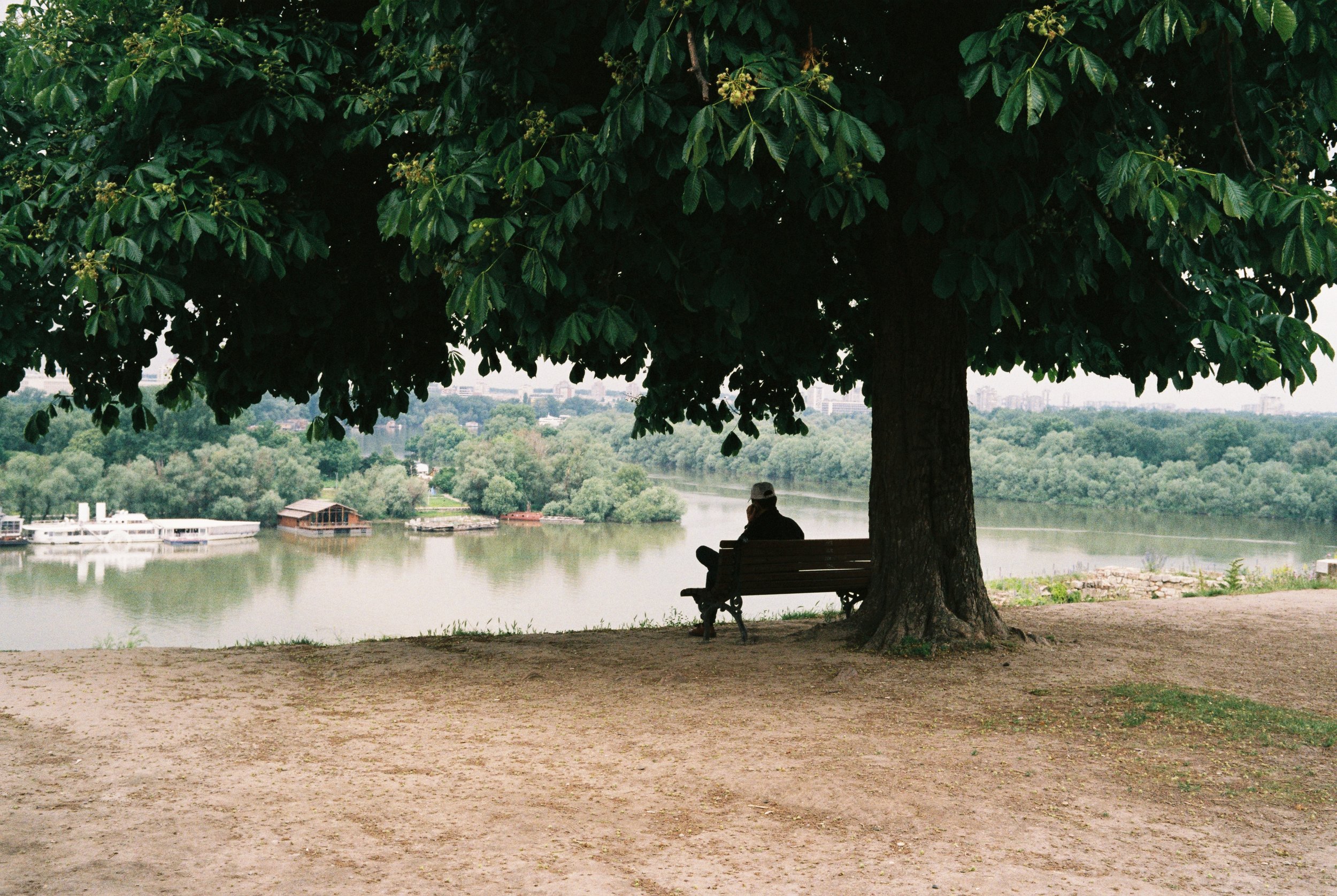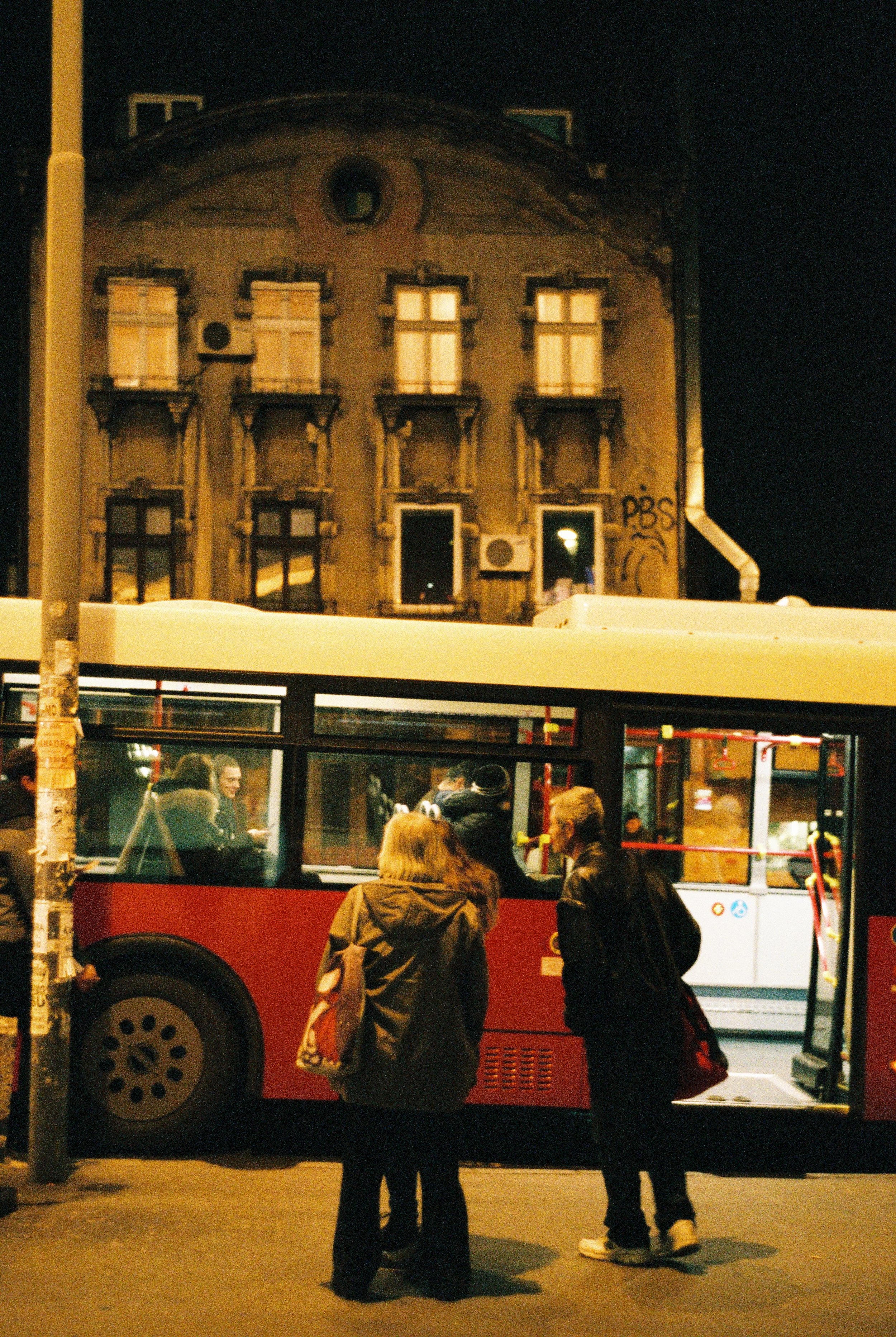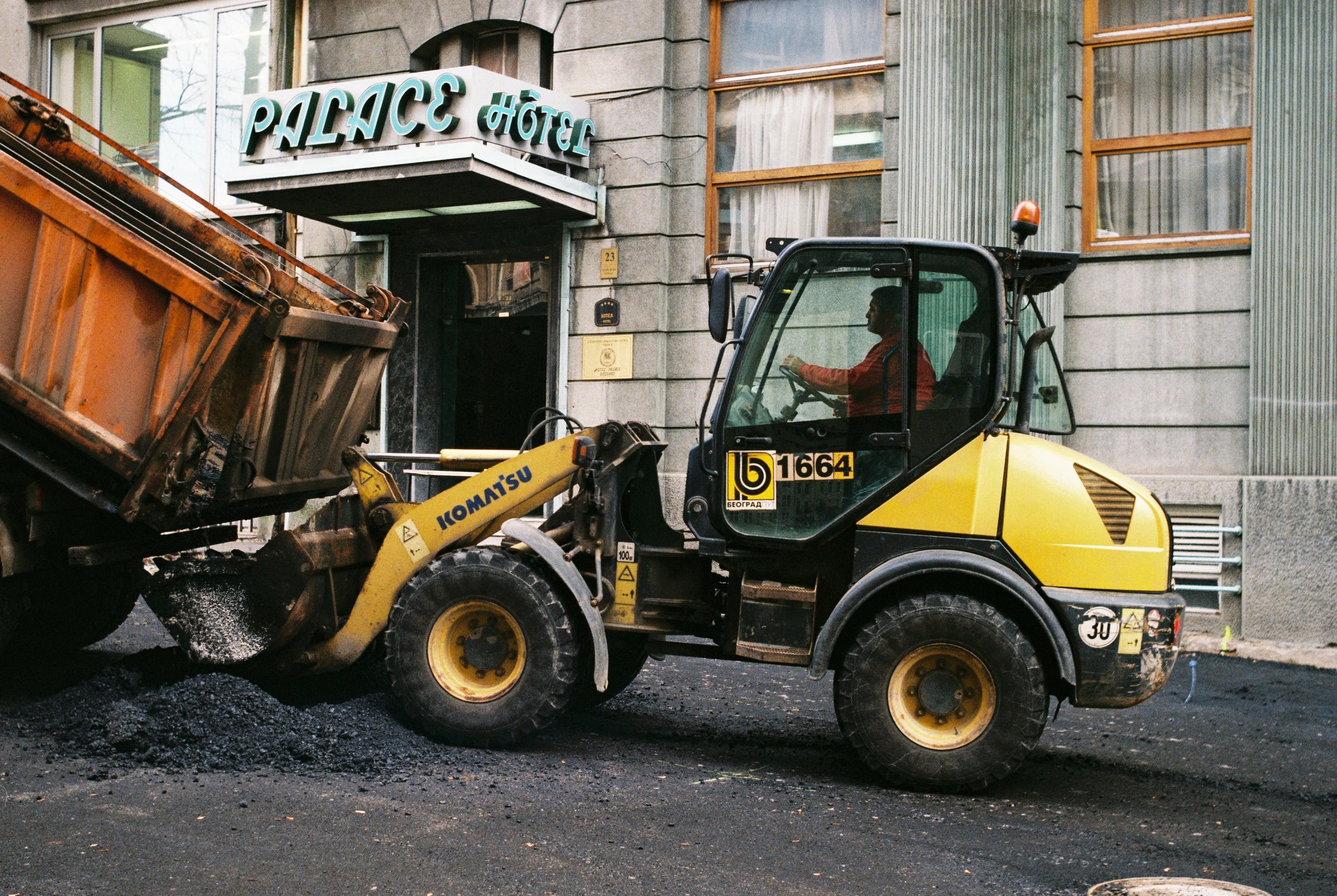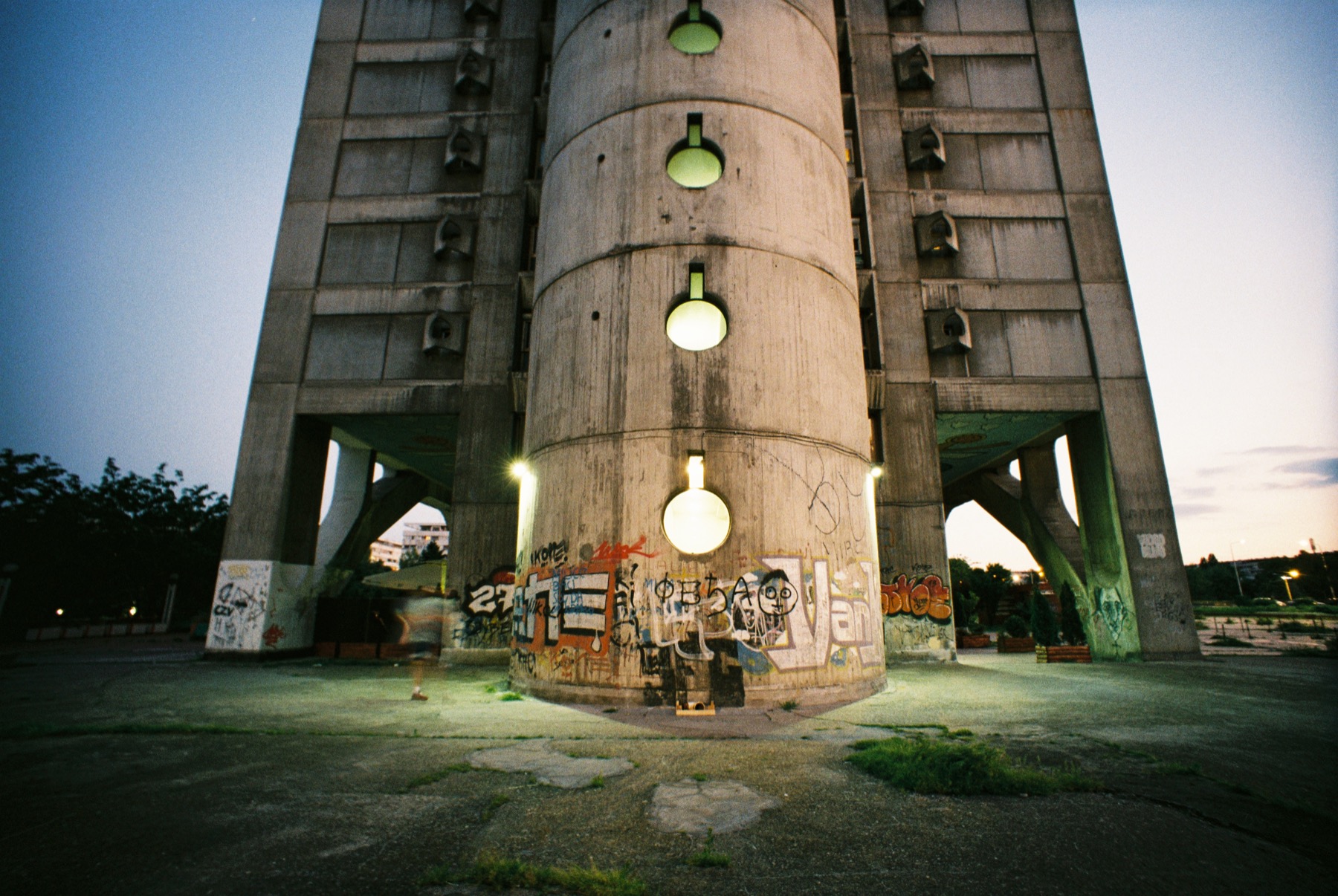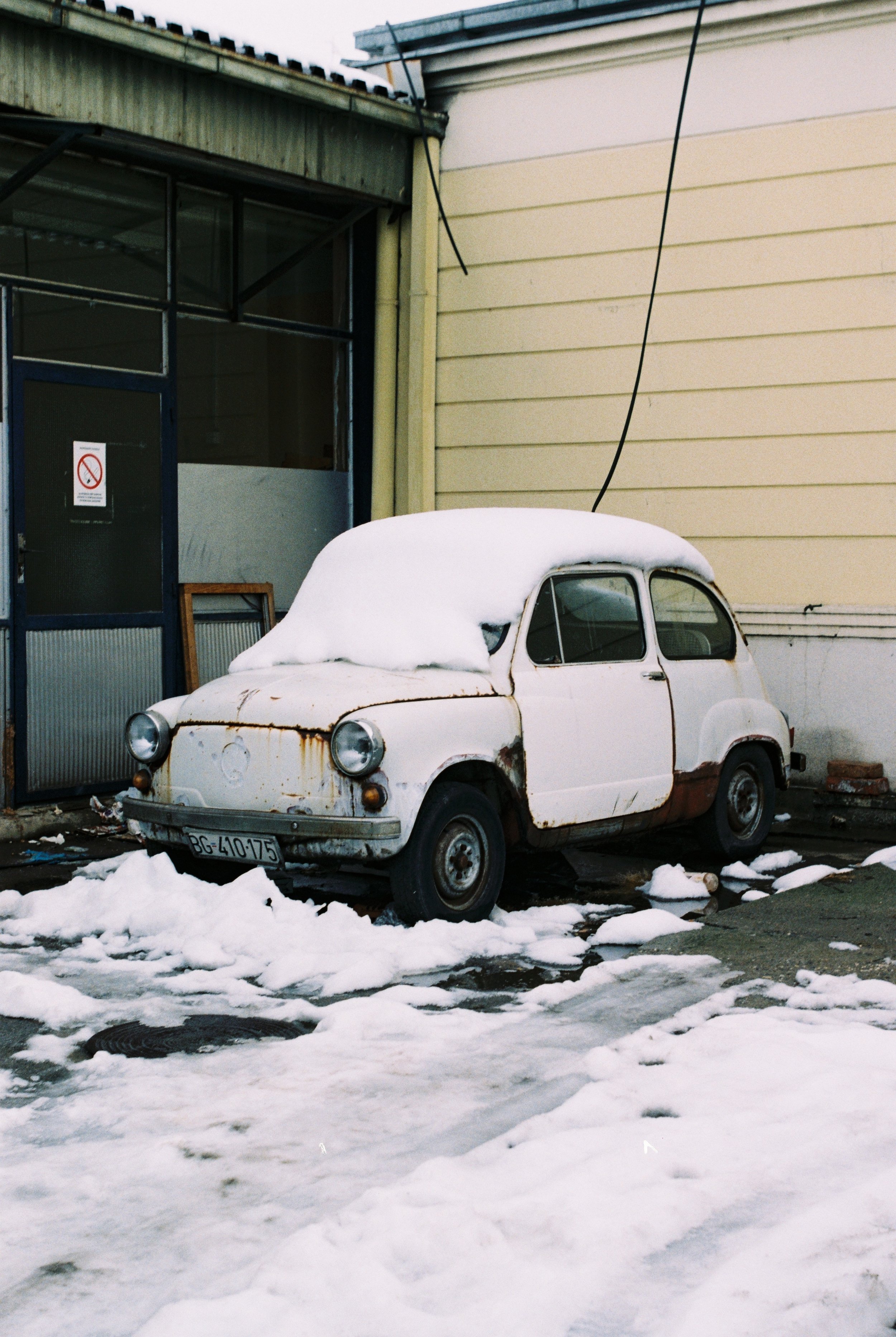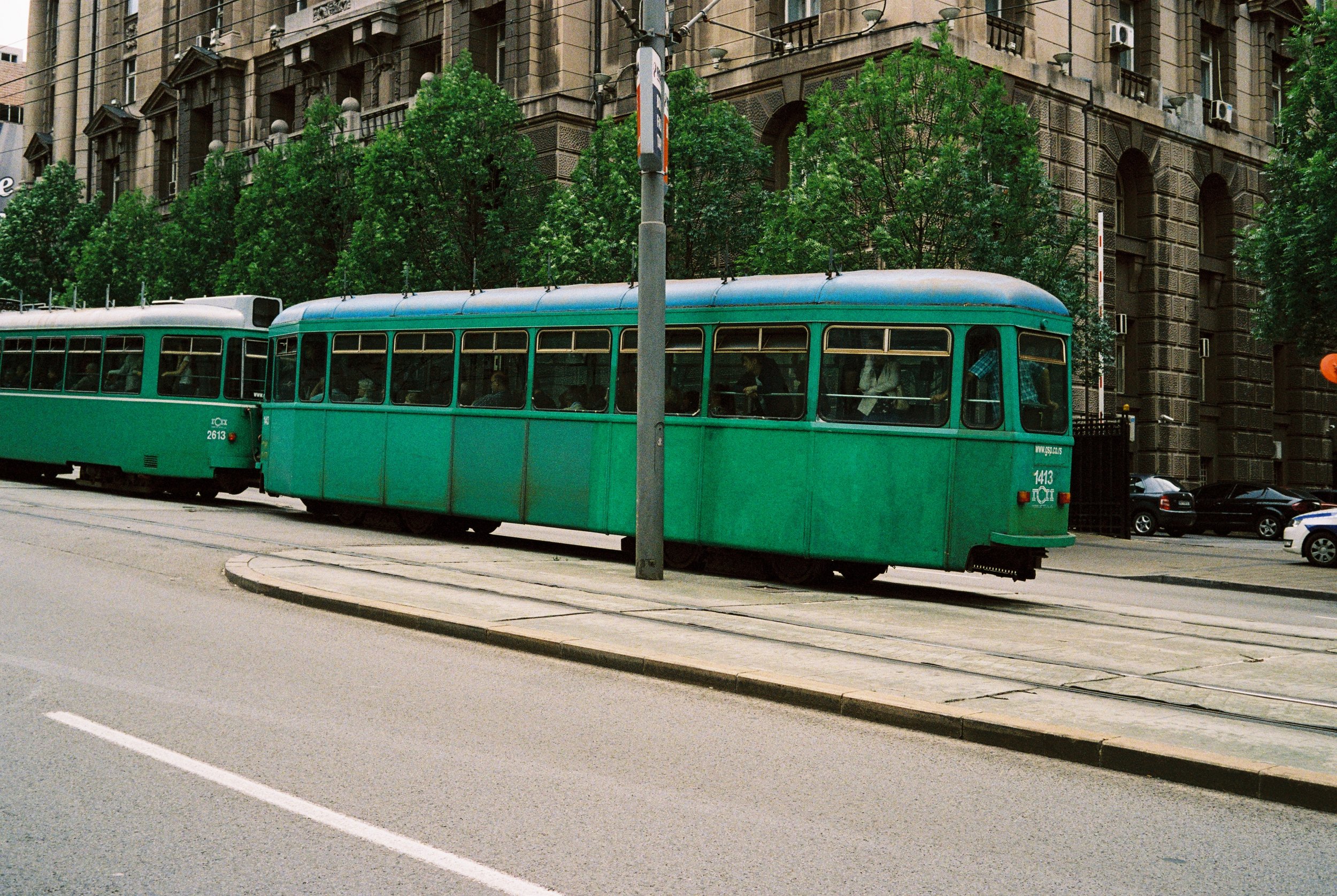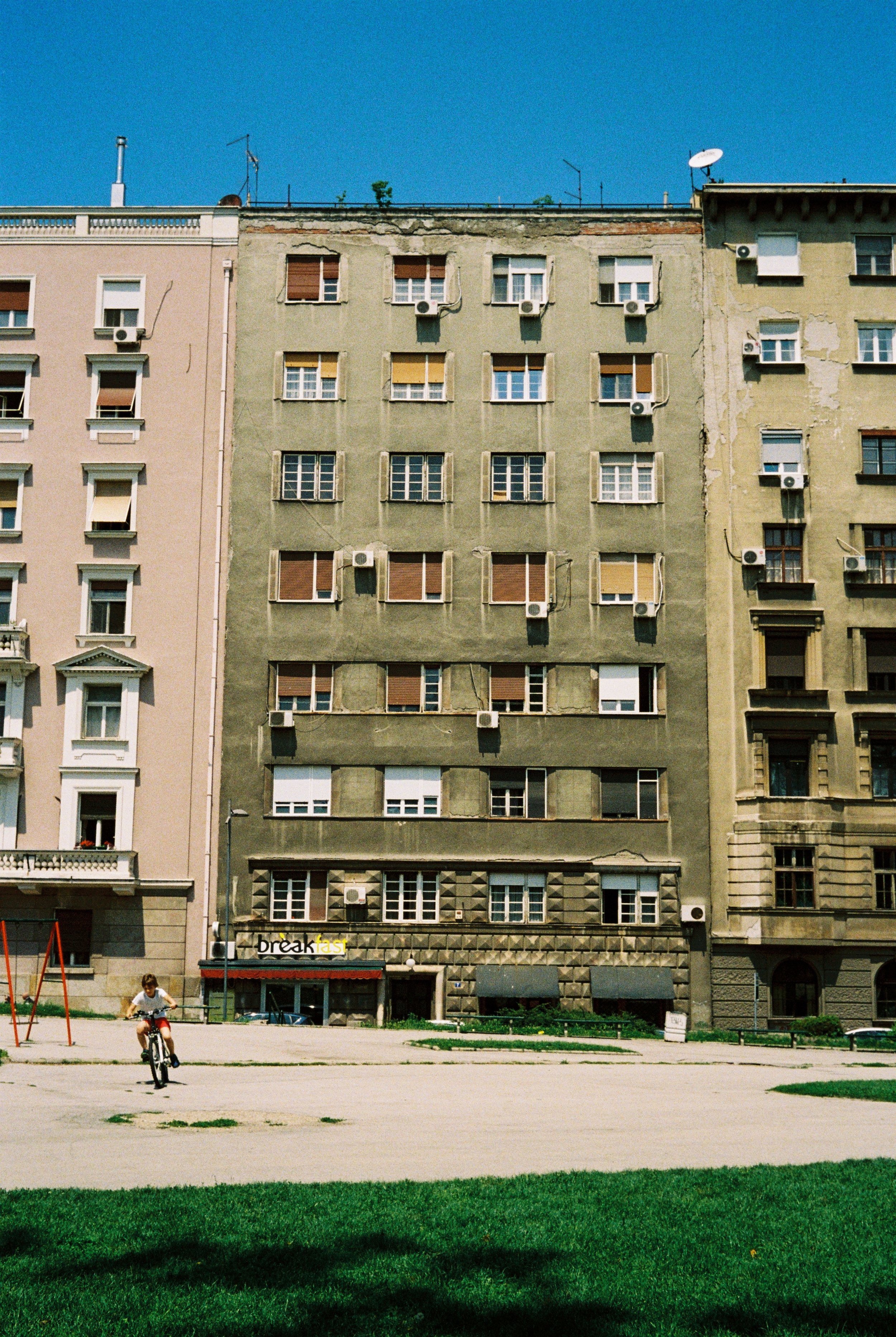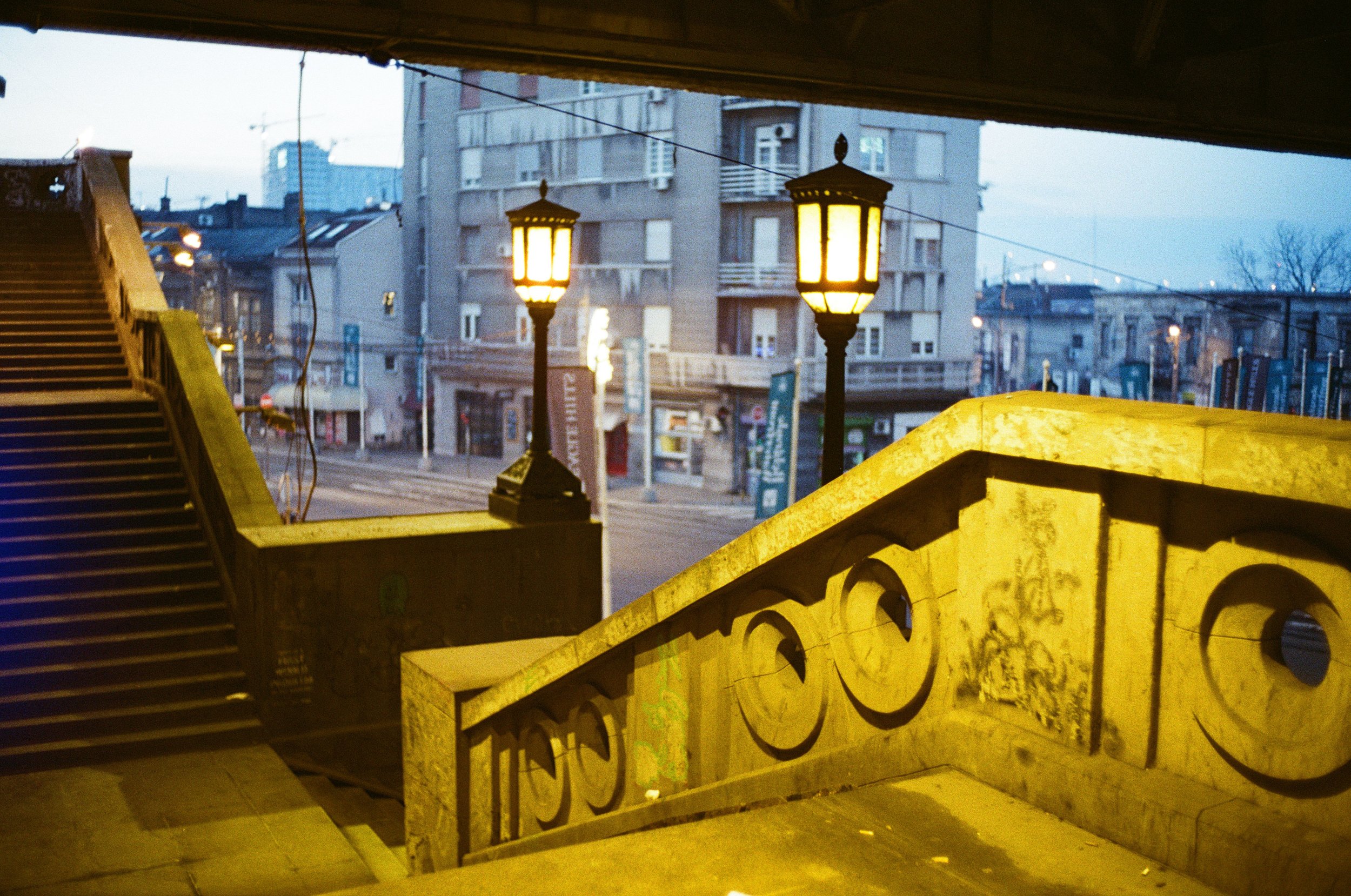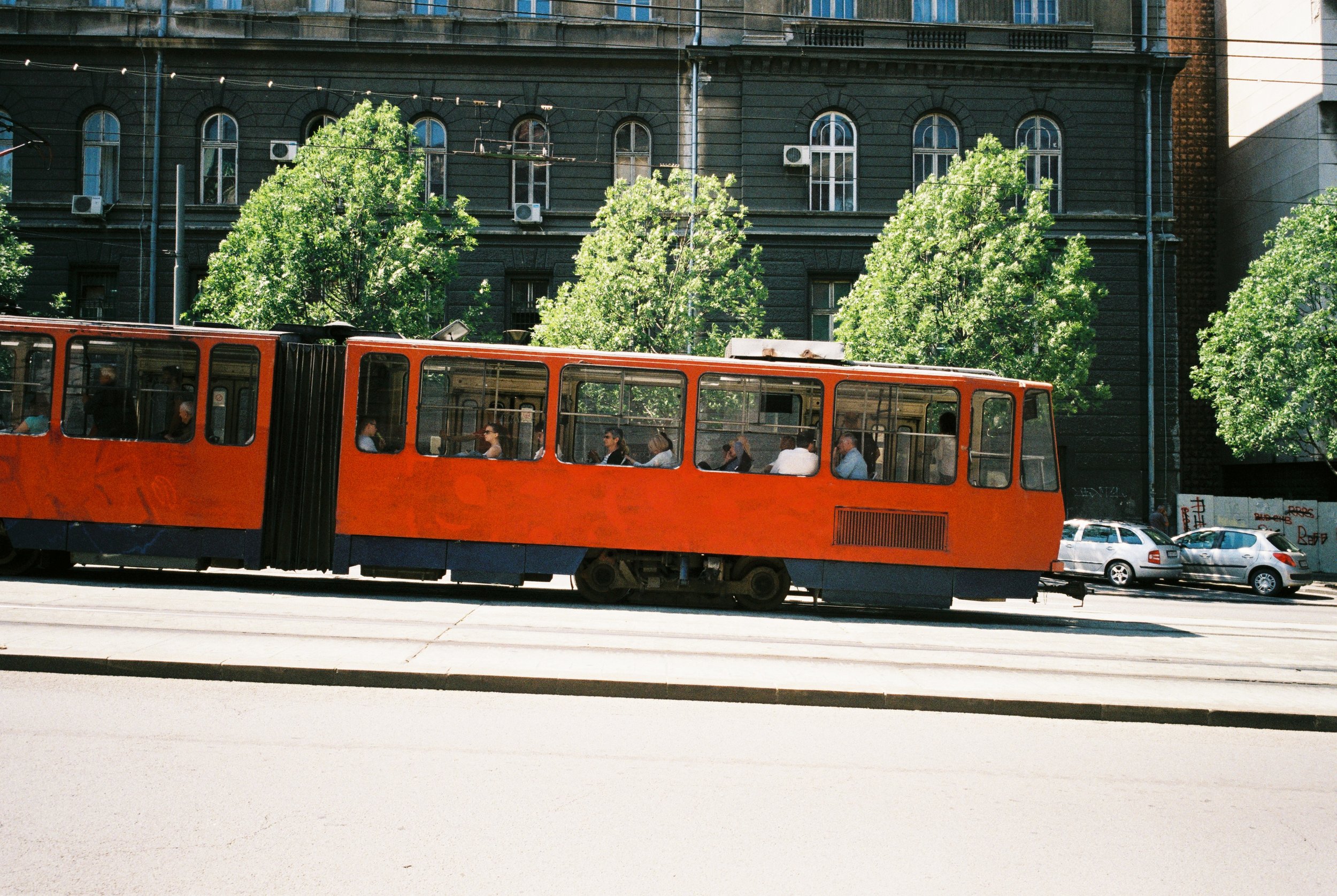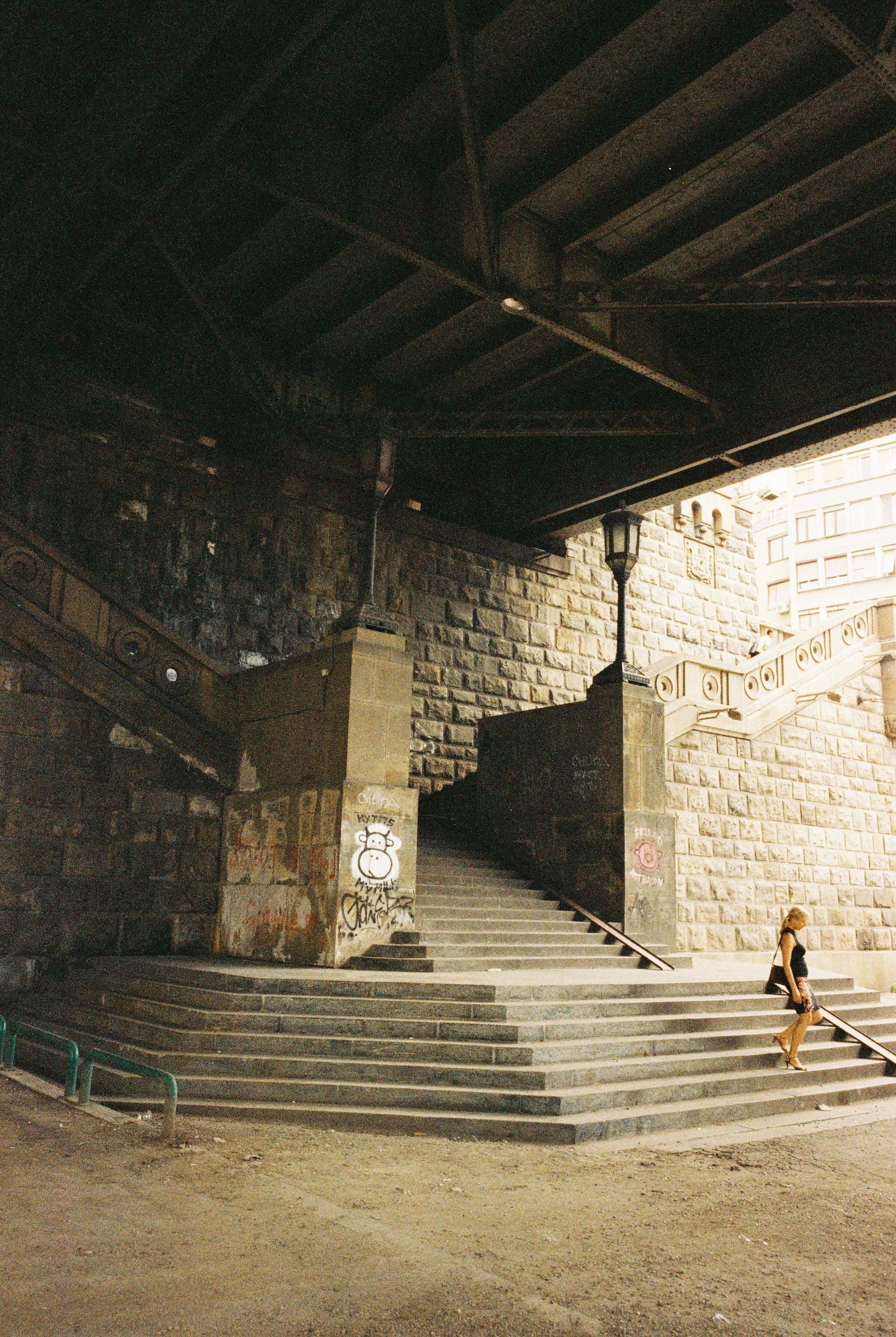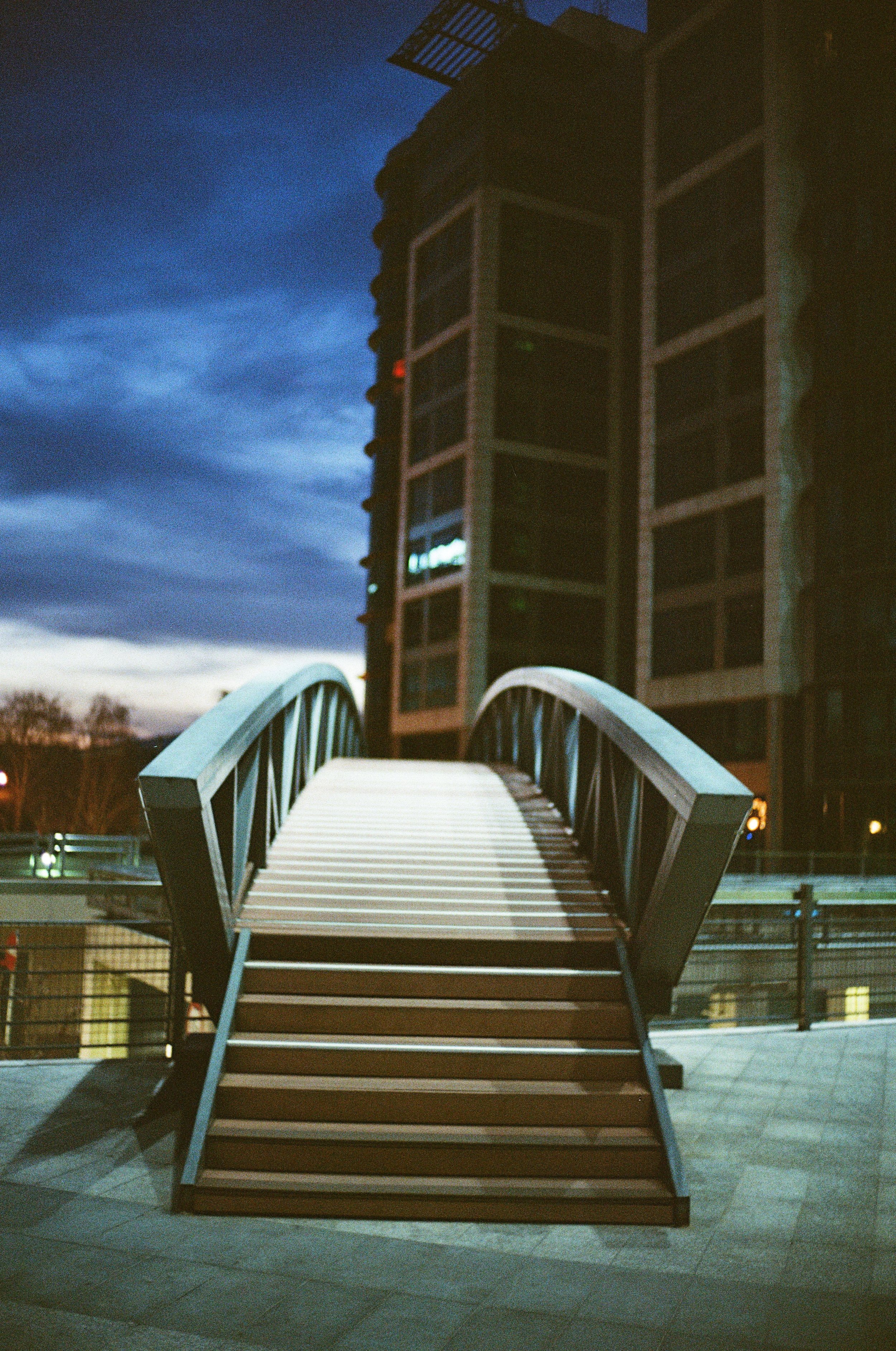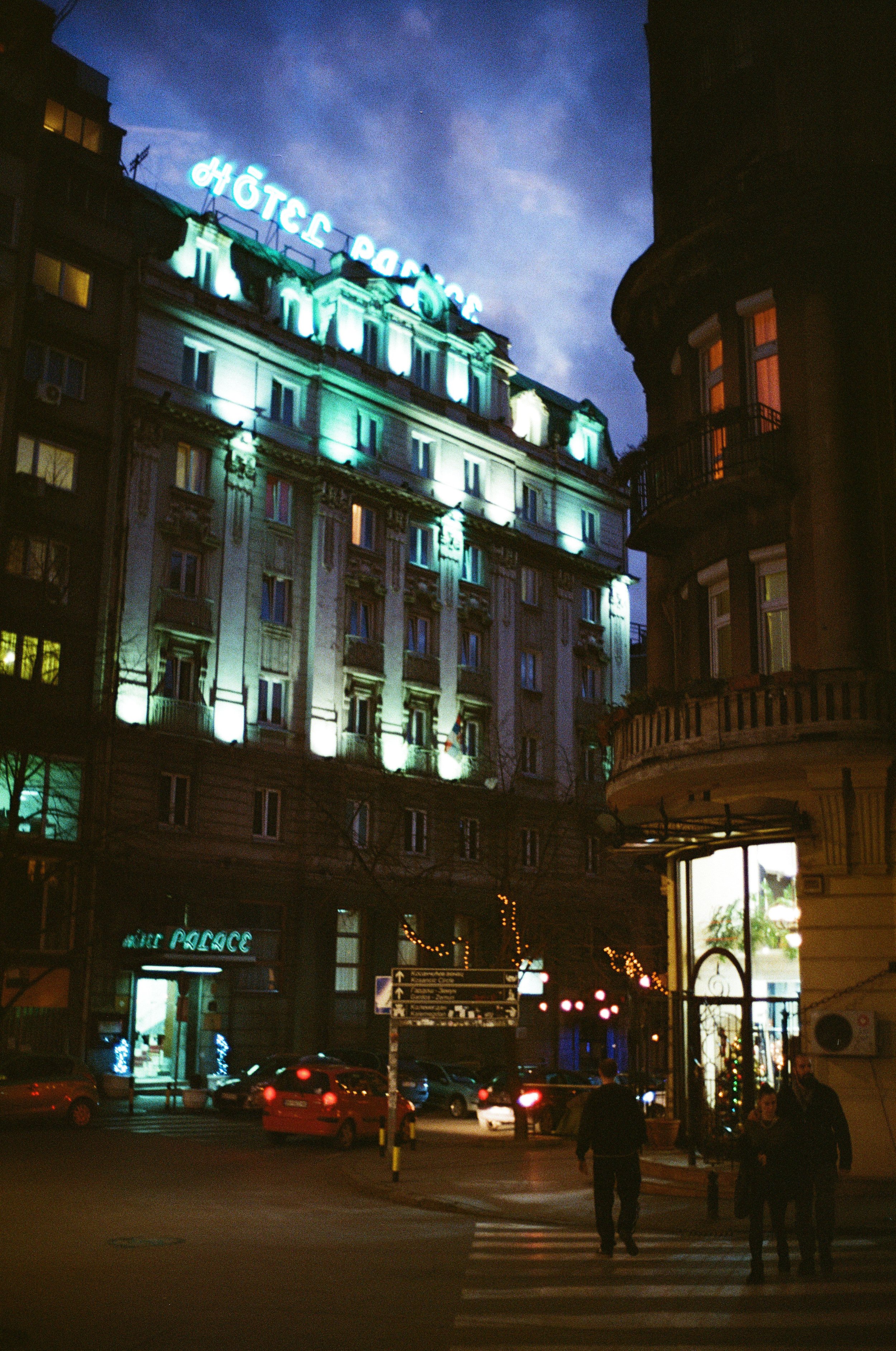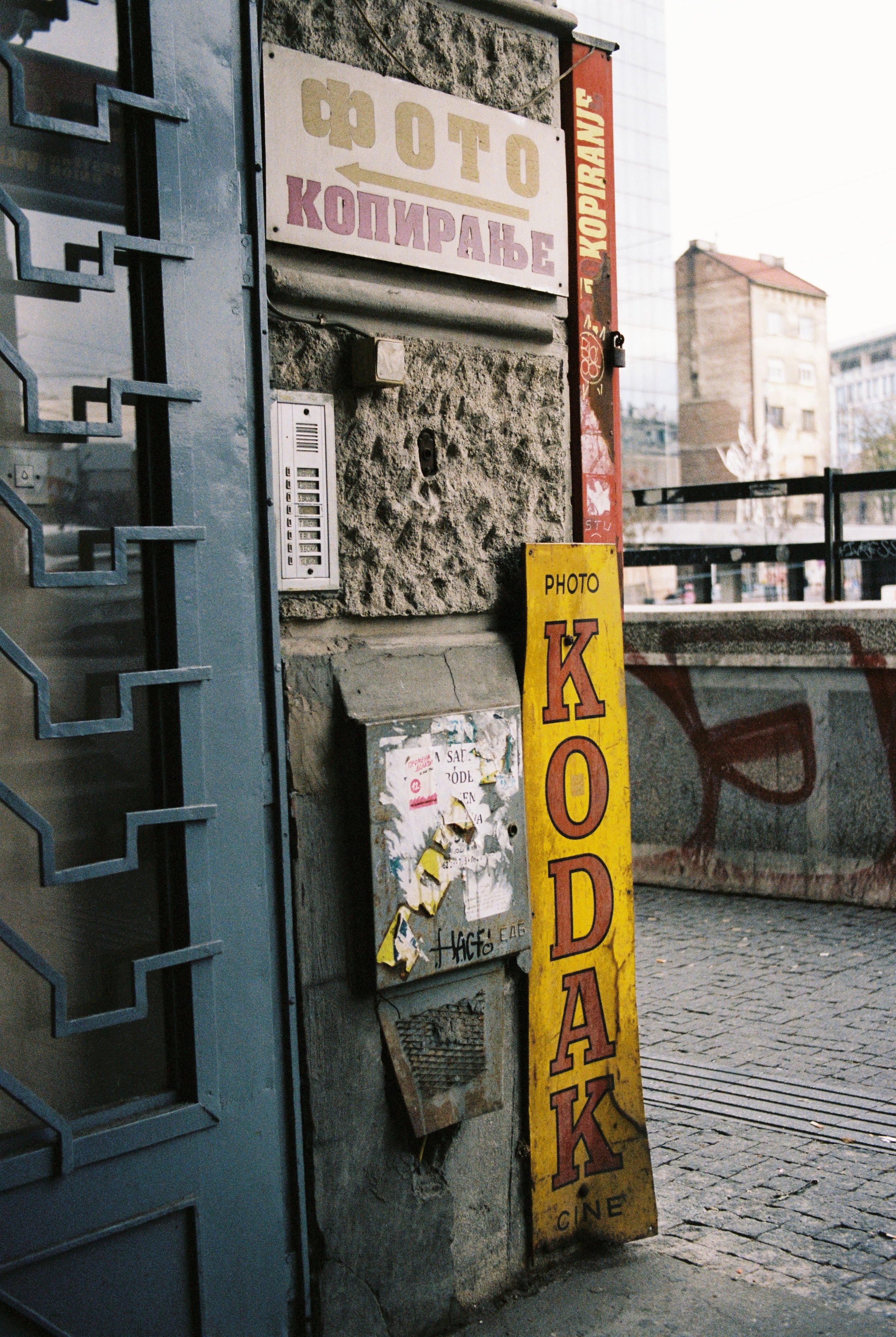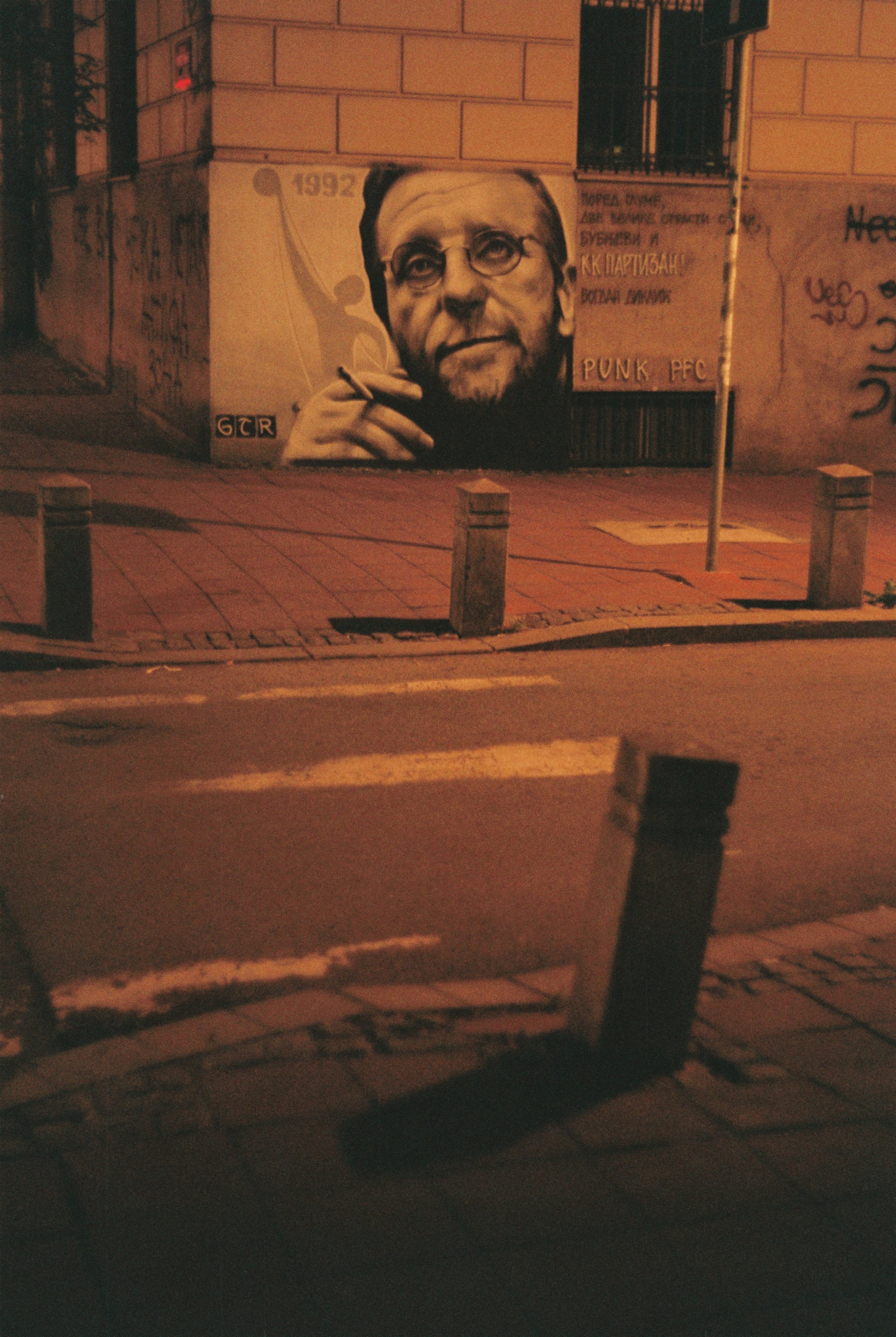Through my film photography I try to seek out the balance and imbalance of modernization vs preservation through architecture. Every few weeks for the last year and a half I have been traveling to Belgrade, Serbia documenting the gentrification taking place on the shores of the Sava River.
If you are a regular to cameraville.co you will find this is a departure from my usual content. Though all images were made with various film cameras they are not mentioned nor is this a review.
A Foreman and His Supervisor Overlook the Eagle Hills Construction Progress on the Belgrade Waterfront - 2017
Currently here in Belgrade there is a massive push towards modernization with the development of the new "Belgrade Waterfront". The Belgrade Waterfront is a 3.4 billion dollar (reported) a mega-project led by a private Saudi Arabian investment company company Eagle Hills. The company themselves describe the project as "world-class residences and offices, BW Galerija, hotels, educational institutions, modern healthcare amenities, as well as a 1.8-kilometre long public waterfront edge and public parks featuring leisure attractions."
Since the project was first announced in 2012, it has been hastily operated and shown little regard for formalities sparking continual controversy for the last half decade - from having no international design competition, no bidding on the project, to illegal bulldozing, lapses in pay, and worker deaths from reportedly unsafe working conditions.
Abandoned Building on the Belgrade Waterfront - May 2017
It was the Spring of 2012 on the Sava River in Belgrade when Aleksandar Vucic along with former New York Mayor Rudy Giuliani first announced the Belgrade Waterfront Project to the public. At the time Giuliani was “advising” Aleksander Vucic who was then running for Prime Minister of Serbia. Later that month Vucic went on to win the election and in later years, the Presidency.
“We’re here to give advice to Mr. Vucic, who is running for mayor, about economic development and about how to organize a program to redevelop Belgrade, make it into a great world city”
Belgrade Waterfront Project - October, 2018
Giuliani, a vivid supporter of the NATO bombing of Serbia just 13 years earlier, seemed like an odd advisor to have present at the announcement of the Waterfront Project. The Belgrade Waterfront that Giuliani supports will literally build bridges in the same place where he previously encouraged their destruction. Dragan Đilas, Vucic’s rival at the time seemed to understand this awry juxtaposition.
“..those who brought Giuliani to Belgrade to show him the ‘Belgrade on the Water’ project, could also have shown him the buildings destroyed in the bombing.”
Yugoslav Ministry of Defence Building Still Damaged from 1999 NATO Bombing - Summer 2017
A Giant Advertisement on the Old Train Station with a Render of the Future Waterfront
In a country where the average wage is under 500 USD a month (a per capita economic output equal to Iraq and Libya), many residents are unable to see the benefits of unsolicited luxury high-rises and world-class malls, but to see this you have look several decades into the future, and understand who will really be the beneficiary.
Bw Aurora Apartments on the Waterfront Half Way to ‘Topping out ‘ as Seen from the Old Train Station - Summer, 2018
Belgrade is not the companies first venture outside of the Middle East. Eagle Hills is actively developing a project in Morocco, and just announced plans for a mixed-use development in Ethiopia with over 4,000 homes. Eagle Hills states that their mission is to "be the global provider of quality lifestyle communities and leading iconic destinations in emerging countries, providing sustainable economic growth."
A Man with with a Briefcase Walks Through a Construction Zone Heading Towards the City from the River - April, 2017
In January 2014 Serbia officially began negotiations to join the European Union, with unofficial negotiations starting in 2012, that same year that Eagle Hills and Belgrade conjoined. If Eagle Hills wants to be the "..global provider of - communities - in emerging countries.." securing a position in the Serbia is an obvious choice as it is most likely to be the next country to join the European Union. Before joining the EU Serbia will need to settle the ongoing dispute with the territory of Kosovo to the south. Big problems began in 1990 when Socialist Republic of Serbia repealed the 1974 Yugoslav Constitution and began to oppress the Albanian culture in Kosovo. Kosovar Albanians formed an army and took action against Belgrade in 1998. NATO unsuccessfully stopped the violence and in 1999 bombed Serbia until their armed forces were withdrawn from Kosovo.
Overlooking the Savamala Neighborhood - February, 2018
While countries like Montenegro have to first overcome corruption within their own borders, Serbia must overcome the conflict with its neighbors to the South among other things to become a member of the European Union. Not until Serbia is a member of the EU will Eagle Hills begin to garner its greatest rewards from the investment. Their 99 year lease on the land upon the Sava River suggests they understand this resolution will not come quickly.
Construction Zone with the Bw Galleria Mall Rising in the Distance - December, 2018
Peace though seems to be getting further away. Just recently in December 2018 Kosovo adopted three draft laws to turn their lightly armed forces into an official Army. And it was the formation of the Kosovo Liberation Army in 1996 that enabled Kosovo to start an insurgency 20 years ago that sparked NATO intervention and eventually the bombing of Serbia to begin with. All this just one week after Kosovo added a 100% import tariff to all Serbian goods.
Homeowners refusing to sell their land to make way for construction projects is a huge hurdle for development companies. You can find examples all over the world of a seemingly out of place structure in the midst of some other architectural entity due to land owners that refused to sell their property for emerging developments - like the Gate Tower Building in Osaka which has a highway offramp passing through the buildings 4th, 5th, and 6th, floors.
Back in high school my friend and I used to sit on the roof of his house and watched the nightly extravagant firework show put on by Disneyland Anaheim directly across the street. It was the house his dad grew up in and I remember him telling about how Disney tried to unsuccessfully to buy out the neighborhood many times over his childhood. In fact wasn't a construction dispute the catalyst for character of Carl Fredricksen to attach balloons to his house and fly away to South America in the Disney/Pixar movie UP? A Disney fantasy on more ways than one I guess.
I thought the simple offer to purchase and entire neighborhood door-by-door was extreme, until I saw how a similar situation played out on the Belgrade Waterfront.
With a construction site of 1.8 million square meters there is bound to be disputes on the Belgrade Waterfront. Before construction began 231 families living in state-owned buildings had been successfully relocated, although there were still those refusing to leave that owned their own property on the future site.
One night on April 2016, thirty masked men with baseball bats and heavy construction machinery raided an area of interest in the Savamala neighborhood. They tied up bystanders, confiscated cell phones, and demolished the buildings before the sun came up.
Overlooking the Savamala Neighborhood - April, 2017
One notable figure is Ivan Timotijevic, who lives with his wife in a single dwelling surrounded by dirt in the midst of the construction. Their water and power was turned off and they were refusing to move without "adequate compensation". It is the sentiment of Timotijevic and many others that being forcefully removed is not an impossibility. I photographed his house in 2017 seen here with an old yellow Mercedes below some metal scraps.
Timotjevic’s Front Yard - Summer, 2017
Today I cannot access the area as the construction zone has expanded overtaking the walking path alongside the river that passed by Timotijevic’s front yard. Peering through a dirty bus window on a nearby bridge overlooking the area I was unable to find it. I’m unaware whether Timotijevic and his wife’s house still stands.
Watching the Construction, a Man Stands at a Blockade on the Path that Used to lead to Timotijevic’s house - December, 2018.
View from the Train Arriving at the [Old] Belgrade Train Station One Month Before Closure - May, 2018
[Old] Belgrade Train Station During Demolition, November, 2017
The New Belgrade Train Station - November, 2018
In the summer of 2018 the main Belgrade train station closed its doors after 134 years in service as the new modern station opened a few miles away. I discovered this first hand when I arrived to Belgrade confused exiting the train at a grand station I had never seen nor knew existed. For years before the [old] station closed there had been demolitions of the structures behind the train station bordering the construction site of Eagle Hills. From my own observations this area was main dwelling grounds of refugees living in Belgrade as they attempted to transition into Europe. Since my first visit photographing the area behind the train station in early 2017, I had seen people digging through the rubble looking for things of use or any monetary value.
Refugees Wandering Through the Rubble Behind the Train Station - May, 2017
In and around the area I could see remnants of people living there, in burnt out cars and abandoned trains, I would find mostly trash, clothes, feces, and old mattresses.
Today still find signs of life but no people themselves, like these clothes on the ground. Arranged in such a way to to let them dry in the sun after perhaps being washed in the river - now surrounded by snow and covered in dirt, no one has yet come back to retrieve them.
Clothes in the Sun - December, 2018
Several times international news outlets did stories on the refugees transiting through Belgrade. Most times they cameras did interviews amongst the wreckage in this area behind the old train station. For a while the location seemed to be the zenith of expression for the refugees via graffiti on the walls in broken english, like “Border Police Be Kind”.
Behind the Old Belgrade Train Station - June, 2017
Phrases like this may refer to the intermittent reports of some refugees crossing between various borders in the Balkans being beat and robbed by Border Police. “We Want to Hunman” - possibly an effort to say “We Want to Be More Human”, or ‘seen as’ more human. Other messages I saw overtime read “I am a person too”, “Help me - open the borders”, and “More money more problems”.
Behind the Old Belgrade Train Station - June, 2017
Old Belgrade Train Station - December, 2018
Another day in the summer of 2017, fifteen minutes south on foot from the old train station, I wandered off the makeshift walking path through the construction zone, just a bit past Mr. Timotjevic's house. I saw some interesting structure behind some bushes and hills of dirt and led followed myself toward it. I've stumbled upon some things before in the dirt, bottle caps, golf balls, old vases, but nothing like this. It was an entire train - rotted, corroded, tilted, emerging from the dirt beneath it.
I couldn't fathom at the time how it got there, and how it had seemingly been there for decades. As I walked on the dirt at the rear of train and stood over it - it was a bizarre sight. Trains to me emote movement, speed, and progression, and here this was stuck in the dirt, forgotten, regressing. I returned a month later and there was no sign of the train. As mysteriously as it appeared it had disappeared.
It’s no doubt that the Belgrade Waterfront was, and partially still is a wasteland. The sentiment of many Belgradians about the waterfront is one of optimism, that finally someone is doing something to the land, helping it get to its full potential of beauty and prosperity.
In 2001 American economist Milton Friedman famously scoffed at Pudong district on the east side of Shanghai along the Huangpu River, calling it a “Potemkin village” that it was built strictly as an economic facade. Today just 17 years later with a GDP of 400 Billion USD, it is the financial capital of the world.
Of course only time will tell what the Belgrade Waterfront project will meet the promises of the politicians and developers but looking at the waterfront today it’s hard to imagine this type of economic acceleration and easy to scoff, but Saudi Arabia at least if no one else, clearly sees something.
One of the highlights of the project is the BW Galerija mall. It will have luxury retail space, an atrium, and parking for 3600 cars, set to open in 2020. Visiting the site in 2017 it was simply another area of industrial regression. Boats and pontoons floated silently in the murky water, abandoned and half submerged. One structure was strewn about such that it resembled the aftermath of a hurricane. So perfectly destroyed and peeking above the waters surface as if to ask for help, or mercy.
Directly across from this location on the west end of the Sava river, there was a colossal ghost-town of a boat, gutted and filthy with enough trash built up on the water at its base you could likely walk across it an board the boat. with a stray dog that sat silently and seemed to have some sort of attachment to the location.
Abandoned Boat - Summer, 2017
Stray Dog at Abandoned Boat - Summer, 2017
A year and a half later I would return to the boat, this time boarding it from a rickety bridge connecting it to the shore. It was no longer abandoned but cluttered with living essentials and had many of the windows covered in plastic.
Abandoned Boat - December, 2018
I quickly encountered an American man in his late forties living on it and supposedly with others inside. Standing in the doorless doorway with his hands in his pockets wearing 2 hats and 2 coats, he eventually told me about his early life in New York and his education at Boston University. He voiced his distain for Rudy Giuliani, Bloomberg, and Trump, how they broke down the public education system in New York and drove out the black population. He told me this in a very intelligible way, not a homeless-man-living-on-a-boat sort of way. Though he did say if he ever came across Giuliani he would “kick him in the nuts” without hesitation.
Kitchen Area on the Abandoned Boat with the Now ‘Topped out’ Bw Aurora in the Background - December 2018
A modern urban anomaly the Belgrade Waterfront Project has brought many values and dreams that do not match those of the local community. Belgrade and its people have an amalgamated beauty which comes from looking at Belgrade for what it is and has been, not what it could be. It’s clear by now that the Belgrade Waterfront is not something that will be stopped, only adapted to.
Due to the subject of this article I have thus far only shown Belgrade from one roughly grim angle - which is not the only angle seen when visiting the city. Please take the time to look below and view some images I have taken showing other more beautiful sides to the city.
















![View from the Train Arriving at the [Old] Belgrade Train Station One Month Before Closure - May, 2018](https://images.squarespace-cdn.com/content/v1/58e7646c3e00be081c92c968/1546518554771-A1SQSONBE787F08EVKAJ/000058.JPG)
![[Old] Belgrade Train Station During Demolition, November, 2017](https://images.squarespace-cdn.com/content/v1/58e7646c3e00be081c92c968/1544633200196-AK8CG5JO8TJLP1PRLMDQ/000045.JPG)



